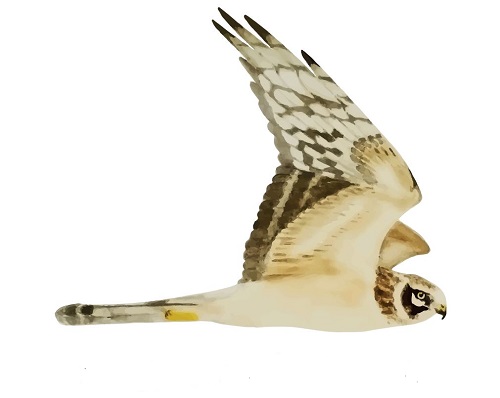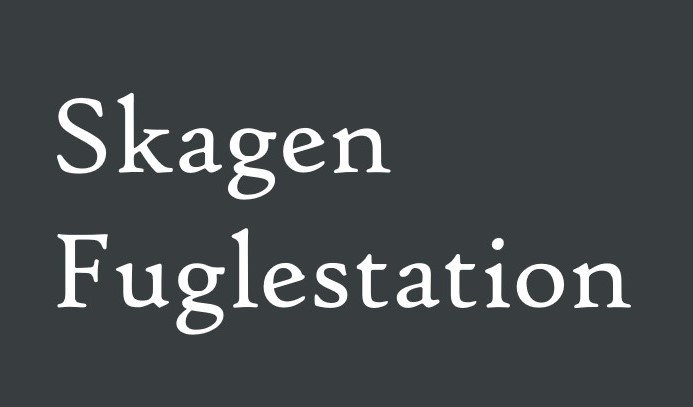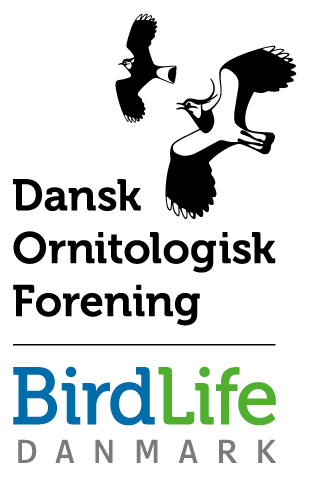Her på Skagen Fuglestations blog bringes korte nyheder i dagbogsformat om hændelser på fuglestationen.
Se indlæg fra måned: jan. (2)feb. (3)mar. (31)apr. (30)maj (31)juni (30)juli (31)aug. (31)sept. (30)okt. (31)nov. (30)dec. (9)
From Morning Madness to Evening Feast
Cora and Simon junior began the day by putting up the nets, and soon Yuri, Lisa, and I joined them for the first round. And what a rining day it turined out to be. The first round already brought some exciting birds, including a garden warbler (havesanger) and a pied flycatcher (broget fluesnapper).
Not long after Simon senior, Agnethe, Erik, and Jørgen joined us. Almost immediately Simon senior spotted a barred warbler (høgesanger) in a bush nearby - and soon after, there were two!
The second round was just as thrilling, with highlights such as an adult male redstart (rødstjert), a tree pipit (skovpiber), and another pied flycatcher (borget fluesnapper). Then, all of a sudden, a Zello call came through: Yuri and Markus had found a barred warbler in the net! We quickly called Sarah and Rose so that everyone could share the experience. Not only did we get to see the bird in its natural environment in the bush, we also had the chance to ring one and admire it up close.
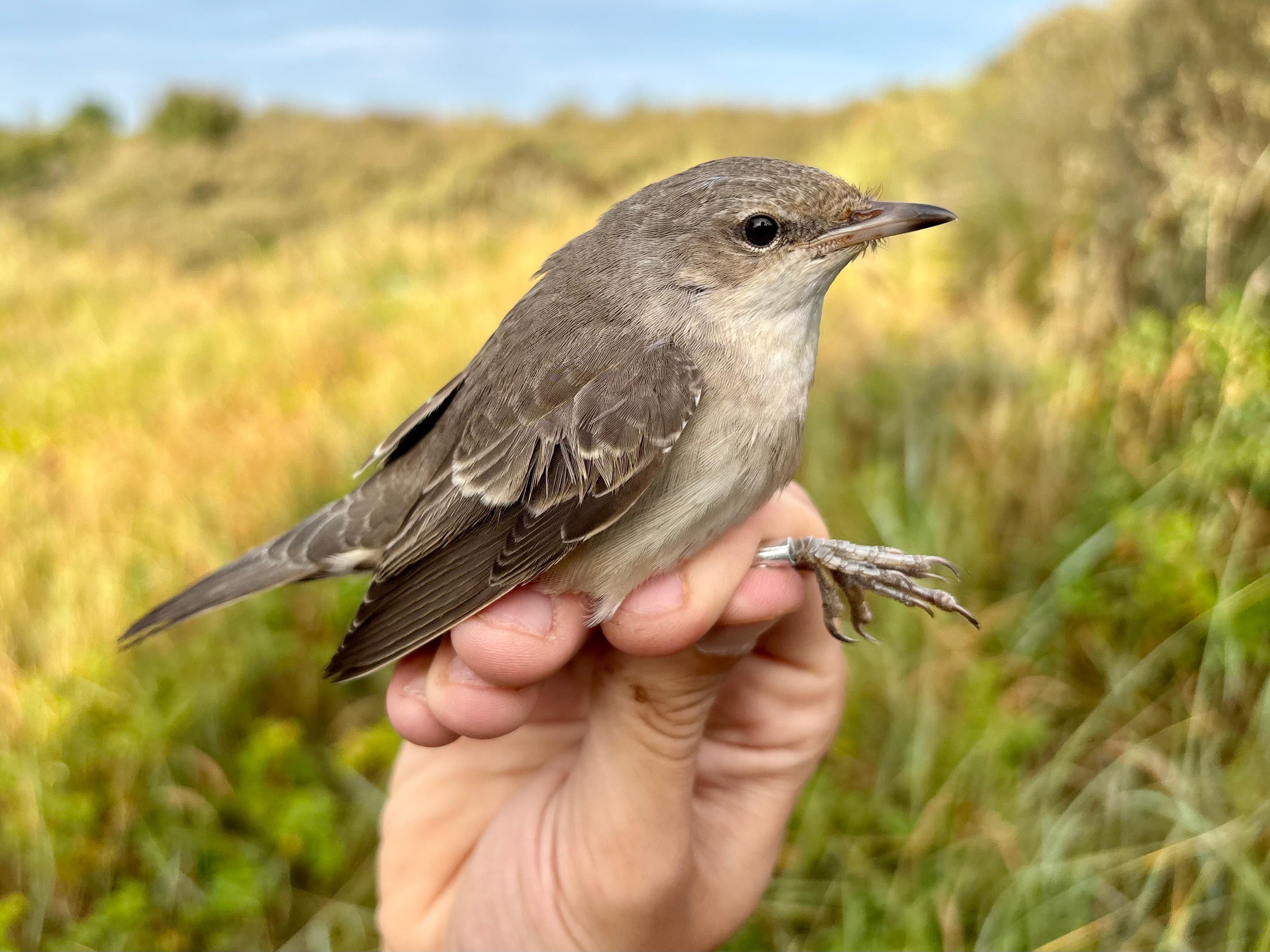
Barred warbler (høgesanger) caught at Kabeltrommlen
However, the morning was not only smiles - we also had to say goodbye to Markus, Cora, and Rose (we already miss you guys!) We gathered at Kabeltrommlen to wish them farewelll (or rather "see you later"). Just when we thought the day had peaked, Simon Jr. spotted an unusual-looking gull slowly approaching Ellekrattet. It turned out to be a long-tailed skua (lille kjove)! It flew right over our heads, and Lisa and Sarah even saw it from their position at World's end III. What a day!
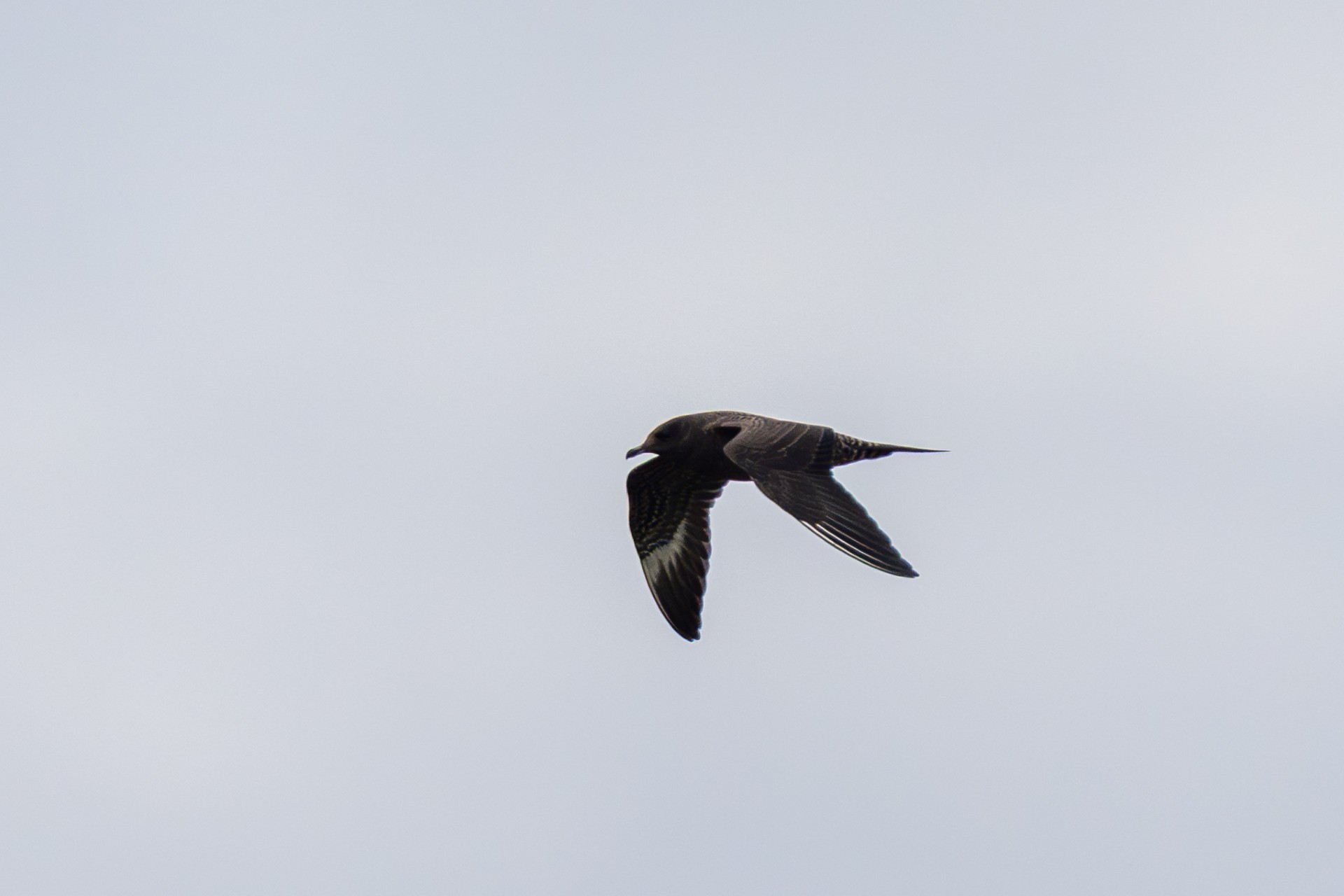
The long-tailed skua (lille kjove), which flew over Ellekrattet (this amazing photo was taken by Erik Christophersen)
Meanwhile Sarah had a beautiful morning of observations at World's End III, first joined by Rose and later by Lisa. In addition, to the barred warbler and the long-tailed skua, they also spotted redshanks (rødben), greenshanks (hvidklirer), and razorbills (alk).
After such an eventful morning, we all gathered for an early meeting at the lighthouse followed by a well-deserved nap. When I woke up, I went shopping to prepare dinner. However, just as I had finished unpacking the groceries, we got a surprise visit from Matilde from the restaurant Blink - bearing gifts: lots of food and wine! So instead of my planned menu, Sarah whipped uo a feast while Simon and I entered ringing data. The spread included fish, chickpeas, salad, fish sauce, and corn - and yes we may have sampled a glass (or two) of the wonderful wine. A huge thank you!
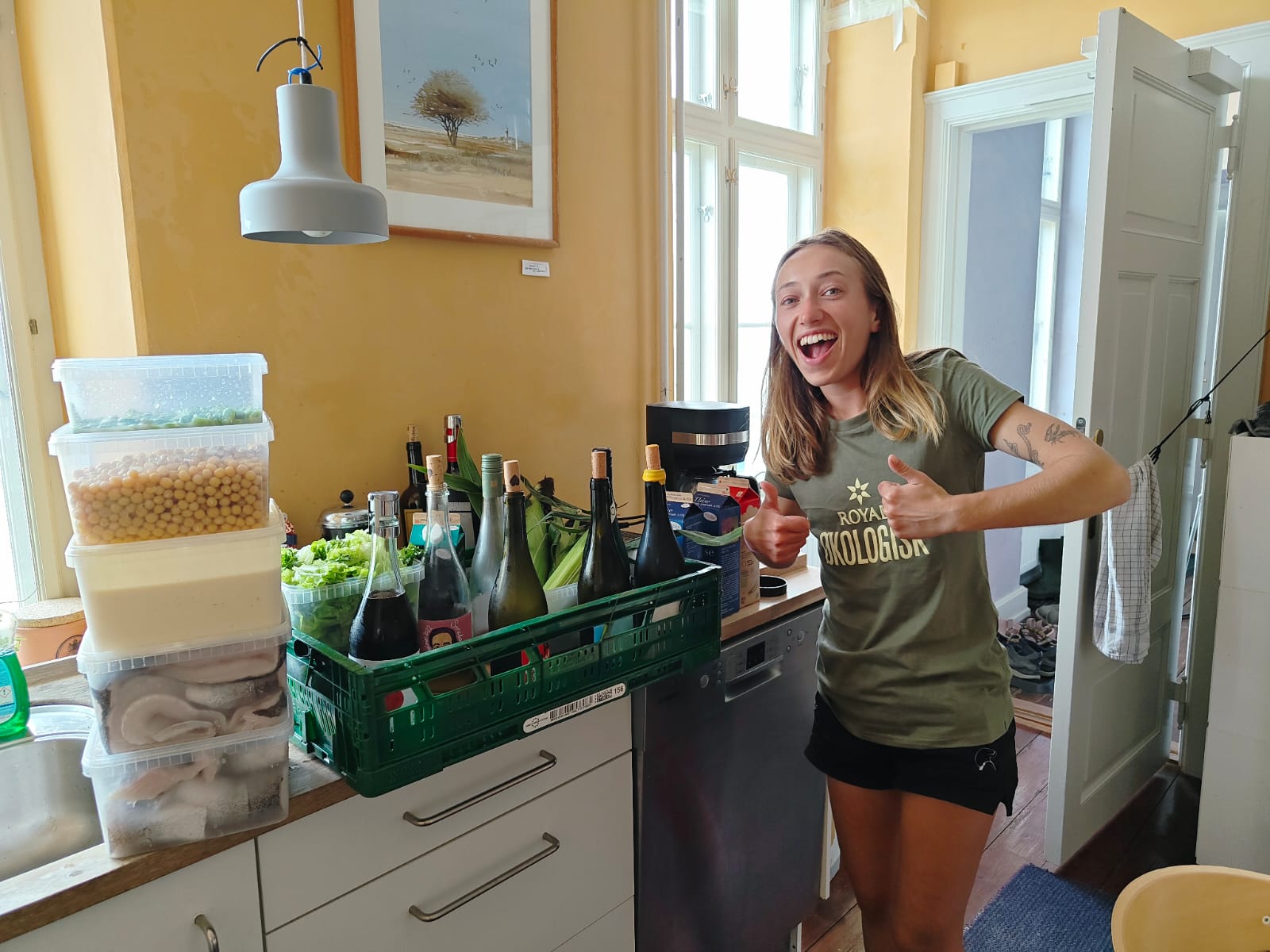
Sarah with the huge amount of food we got from Blink (again thank you so much. I was so delicious)
In the evening Simon Jr was picked up by Simon Sr. to go night-catching for great snipe (tredækker). We wish you the best of luck for your night experdition Sarah and I stayed behind and enjoyed a quiet evenin at the station.
This is my last night here at the station. Time to pack my bags and write in the guest book. Thank you so much for this opportunity to be part of this - it has truely been an honor and a once-in-a-lifetime experience (maybe not once-in-a-lifetime: as you say in danish "jeg har fået blod på tanden" and it is definitely not the last time I volunteer at a bird observatory).
until next time!
Today’s observations by observers in the area of Skagen typed into DOFbasen can be found here.
Ringing at KAB:
1 Høgesanger (barred warbler)
1 Gransanger (chiffchaff)
1 Rørspurv (reed bunting)
5 Tornsanger (common whitethroat)
1 Skovpiber (tree pipit)
2 Havesanger (garden warbler)
7 Munk (blackcap)
8 Sortmejse (coal tit)
1 Kærsanger (marsh warbler)
1 Rødhals (robin)
1 Rødstjert (restart)
7 Rørsanger (reed warbler)
1 Løvsanger (willow warbler)
2 Broget fluesnapper (pied flycatcher)
1 Musvit (great tit)
total: 40
People: Simon Käse, Louise Buksti-Ladefoged, Sarah Partridge, Simon S. Christiansen, Youri Van der Horst, Johan Funder, and our guests
Water rail and goodbyes
Water rail
This morning was very foggy when Rosemary and I went to open the nets at Kabletromeln. Lille Simon joined us, bouncing and ready to go after a full three hours of sleep, for the first round. The day was not too busy with birds in the nets, but a slow trickle came by for us and we got to compare closely the Kærsanger and Rørsanger next to each other. On the second to last round, Rosemary and I walked the nets in opposite directions, and where we met in the middle we saw two water rails (Vandrikse) fly into the net. They are a bit big to get caught in the mesh, and one bounced out straight away but we ran for the second one and managed to hold it inside the pocket. Markus and Louise also came over from World’s End III to see the Vandrikse.
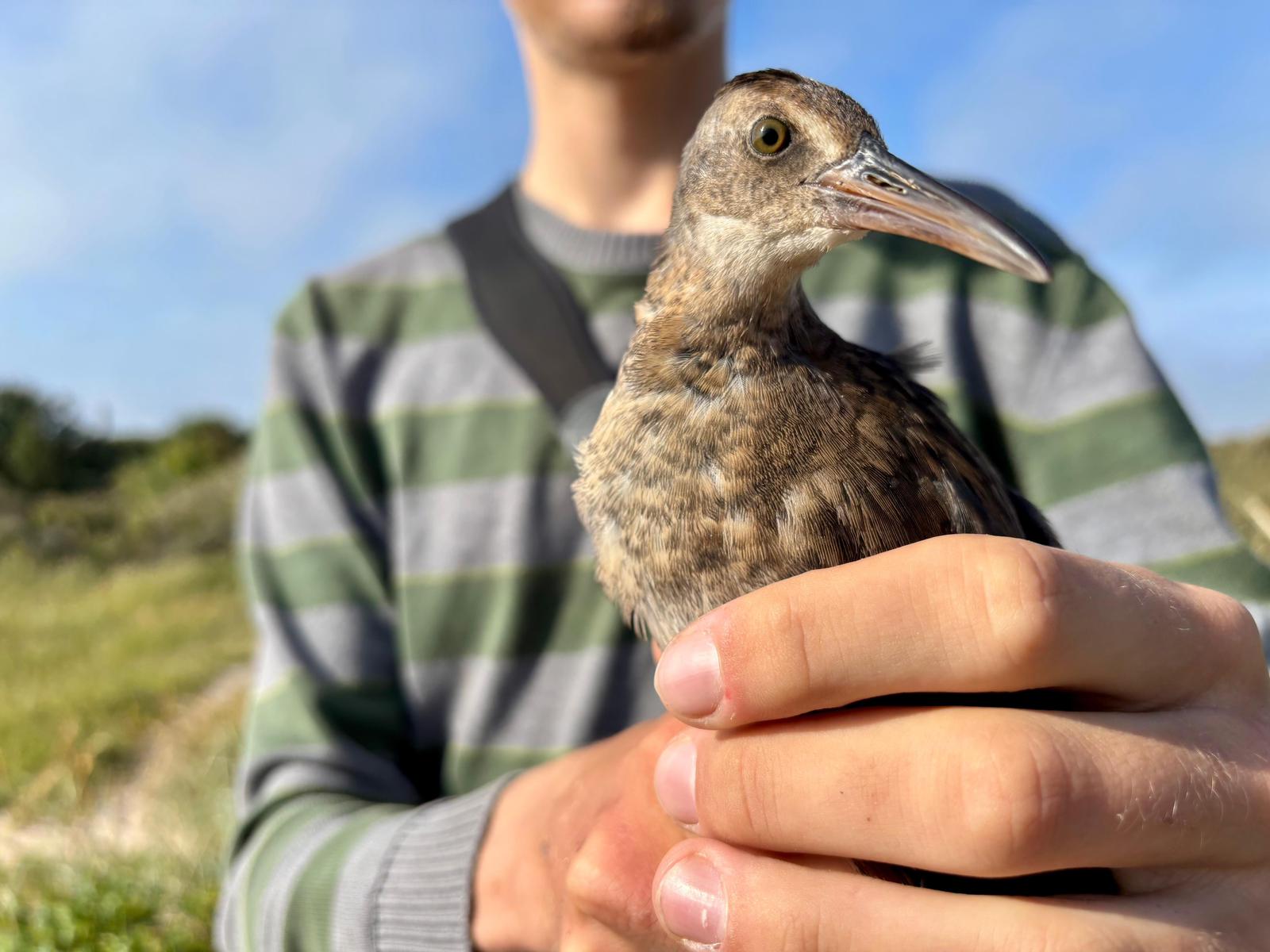
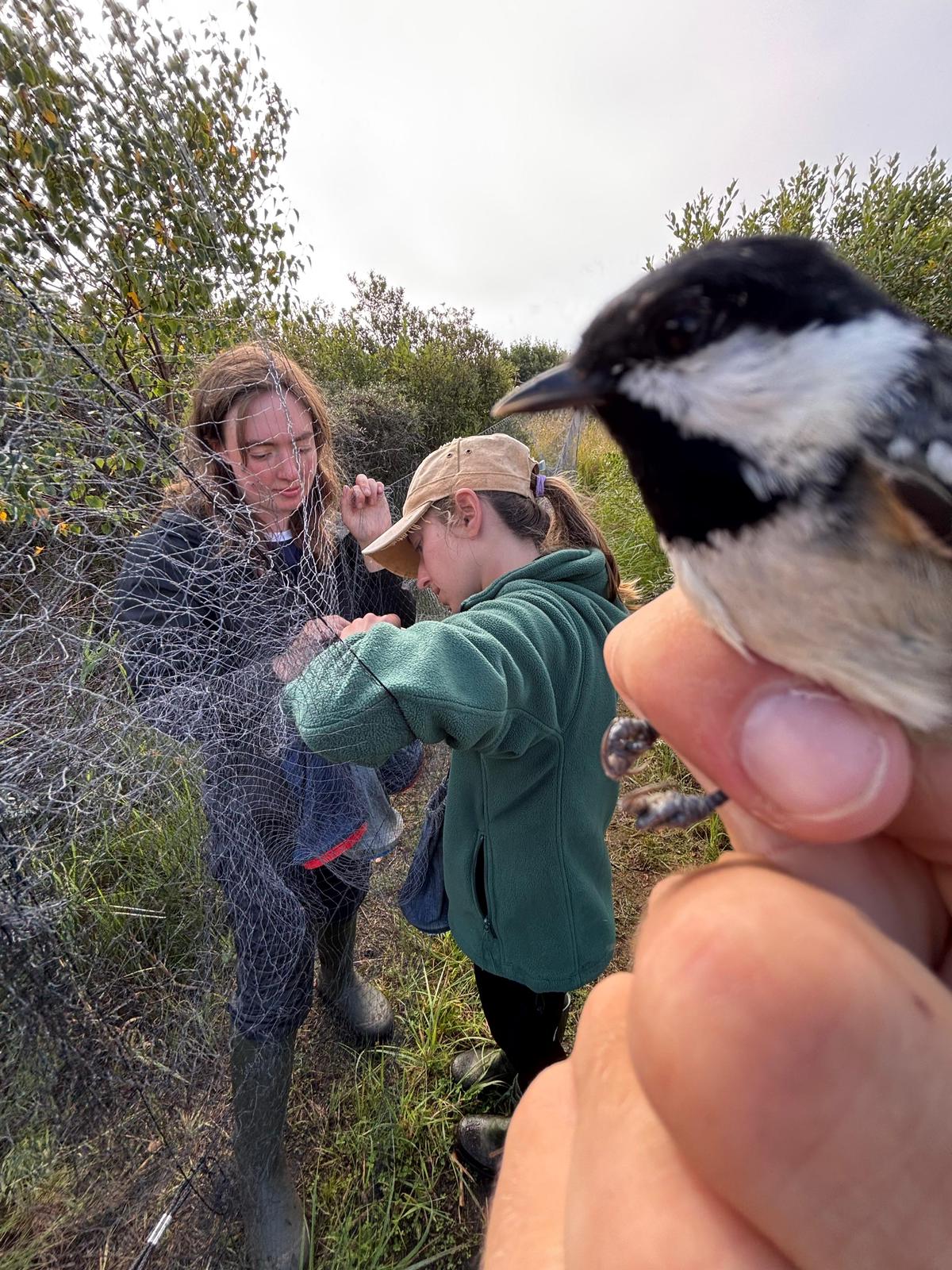
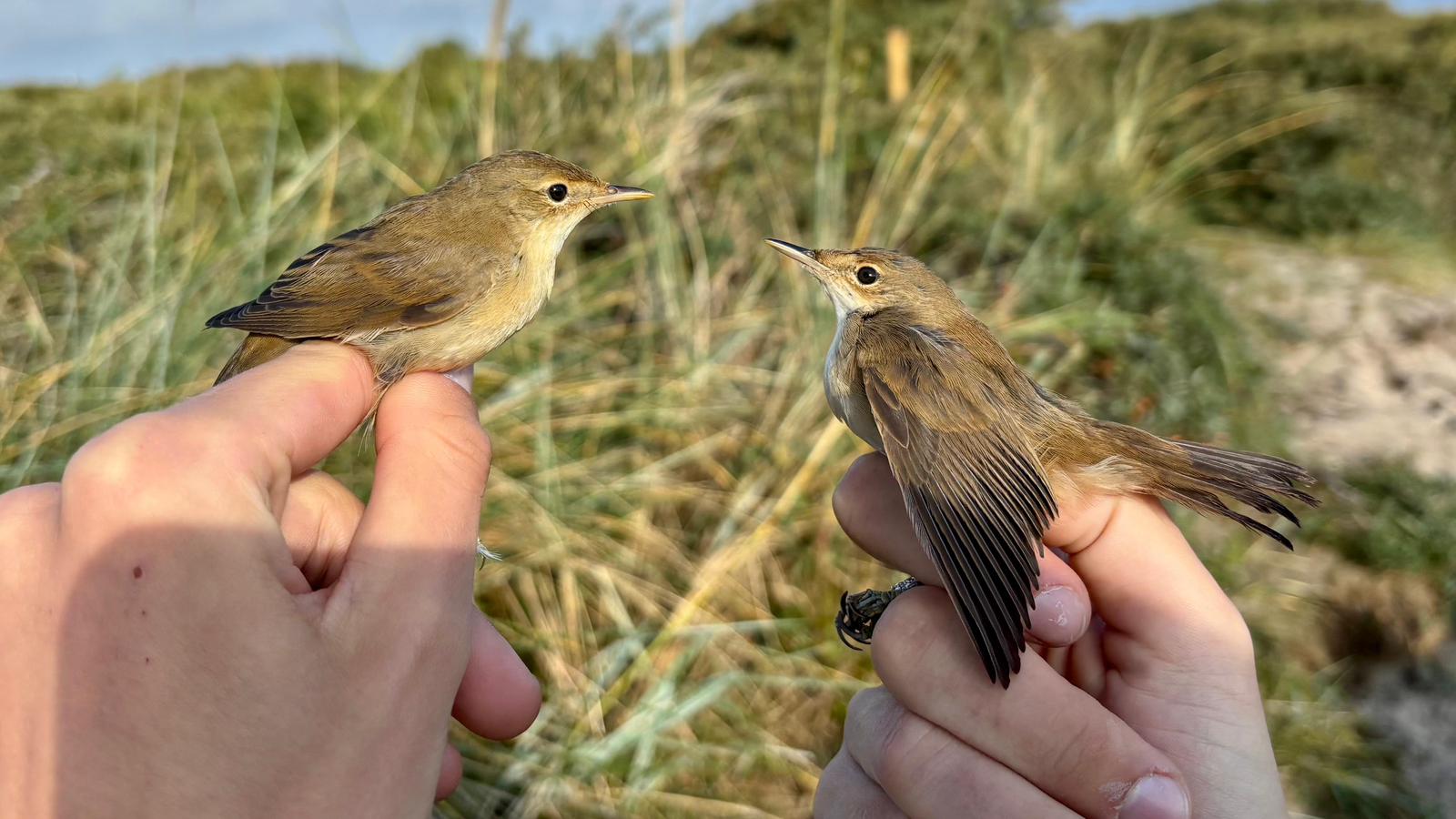
Throughout the day we got to hear about the details of the Snipe mission last night. Cora was missing from ringing and count today because she was unfortunately bitten by a cat that she was trying to rescue in a great act of heroism. She went instead to the hospital with Simon where the doctor told her that no medical intervention is necessary. Most importantly, they saw two Ospreys from the car on the way home. The status of the cat remains unknown.
Markus and Louise went observing at World’s End III, where they saw two Sparrowhawks (Spurvehøg), one young Kestrel (Tårnfalk), and some Alk.
We had a lovely group dinner together in town today, where Boss Simon entertained everyone with his stories about prank calling other bird observatories over the phone, which I enjoyed hearing about very much.
I have some parting words to report from our (very sadly) leaving volunteers.
Markus: “Ciao for now.”
Louise: “I’m not that funny.”
Rosemary: “Uhhh… Eat my jorts.”
It has been a glorious summer season and I am very sad to say goodbye to such amazing coworkers. I am sure they will do great things and we will see each other again in the future, especially my soul mate Rosemary, who I am soul-bound to.
Ringing totals:
Total: 14
Today’s observations in Dofbasen from observers in the area.
People: Rosemary Freak, Markus Kemp Clément, Simon Käse, Louise Buksti-Ladefoged, Sarah Partridge, Cora Köberle, Simon S. Christiansen, Youri Van der Horst, Johan Funder, and our guests Grete and Stig.
Coal day
Waking up after a night with such a big surprise felt great. I was jumping out of my bed, grabbing my overnight oats, checking the rain forecast and taking may jacket to head out. Still thinking about the odd image from last night, when Cora and I headed to the net in the darkness and we approached the Nightjar (Natravn) and then seeing the Nightingale (Sydlig Nattergal) hanging next to it. What a big surprise!
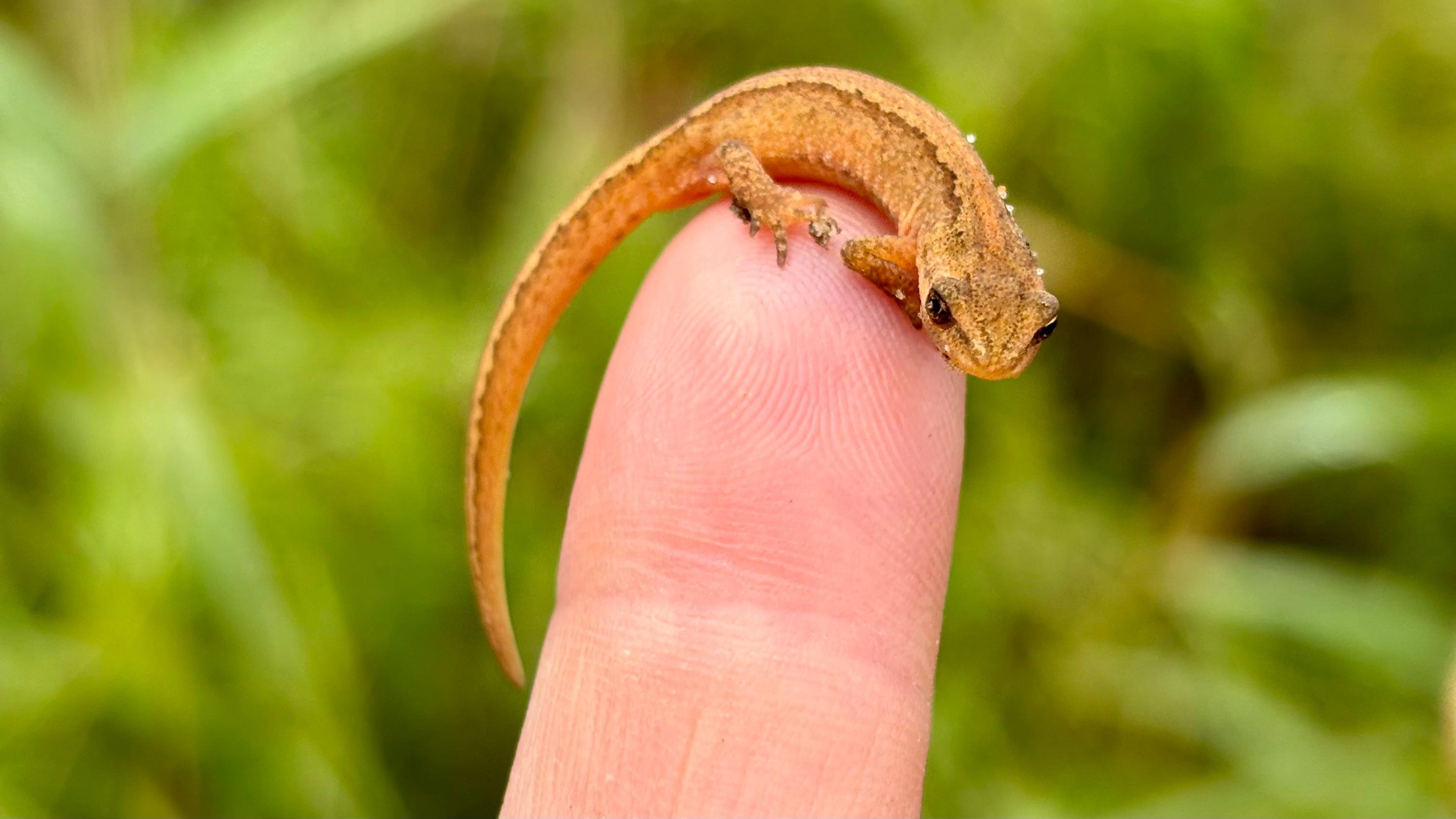 Smooth Newt (Lille Vandsalamander) at Kabeltromlen.
Smooth Newt (Lille Vandsalamander) at Kabeltromlen.
But that was yesterday and we had high hopes to continue our slide on the slide of happiness. While opening nets at Kabeltromlen we already noticed that the rain last night stopped some migration and numbers would be lower today. That did not stop us from ringing three young female Common Redstarts (Rødstjert). The best round came surprisingly late when we closed and flock of 10 Coal Tits (Sortmejse) decided to get a shiny ring.
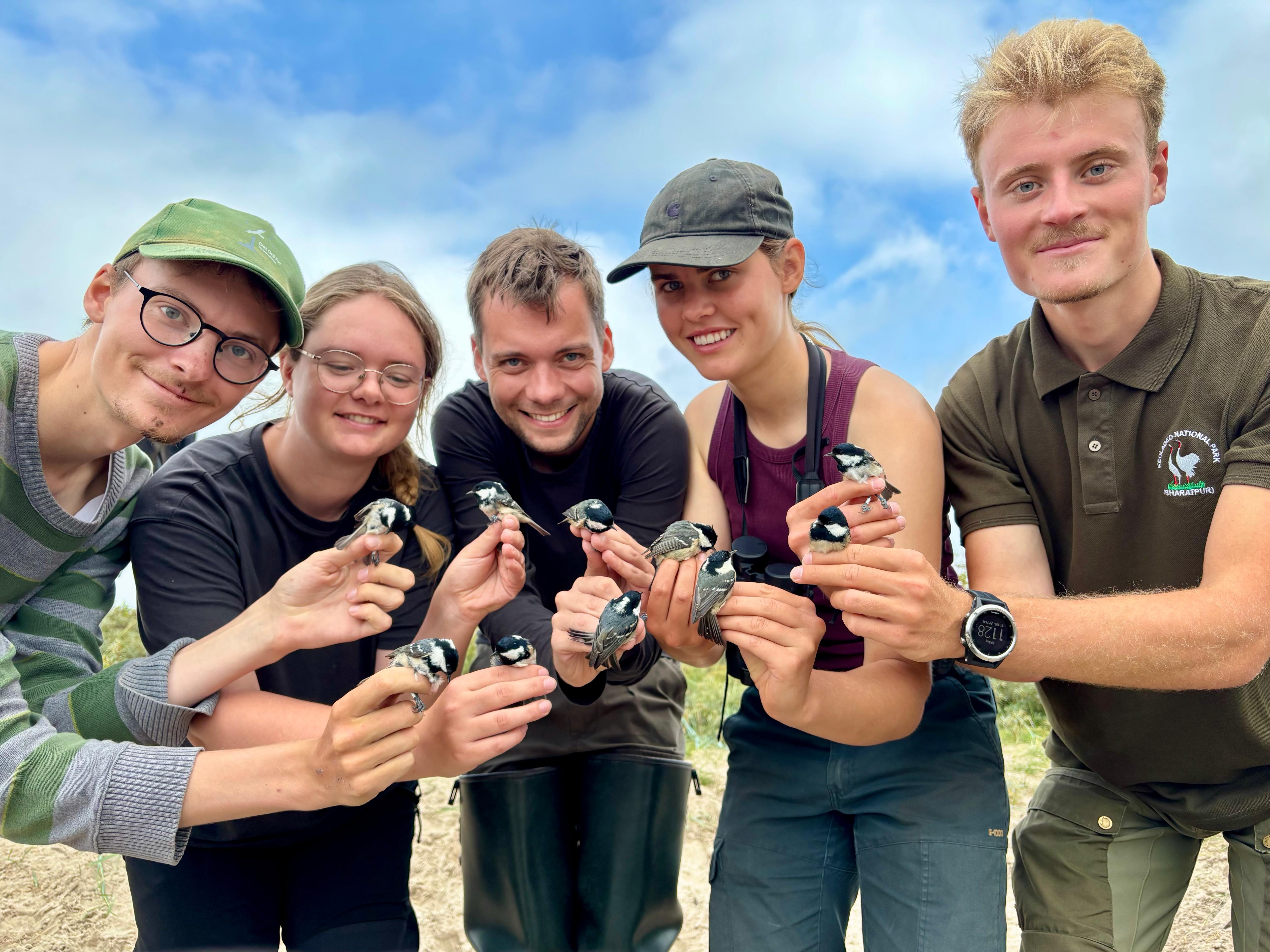 Happy ringers with ten Coal Tits (Sortmejse): Simon, Louise, Youri, Cora and Markus.
Happy ringers with ten Coal Tits (Sortmejse): Simon, Louise, Youri, Cora and Markus.
Coal Tits seem to erupt now, but I’m not sure why. At least until now. Yesterday Falsterbo (Sweden) ringed 22, quite a lot for August and we had 70 flying over Kabeltromlen. A friend of me is currently in Lista (Norway), where they have even more migrating – even a flock with 97 together! I’m excited to see how this pattern continues. All birds we ringed were juveniles, what you can recognize by a moult limit usually somewhere between GC 6-8 and young PC. All birds had a low fat score. I just made this small graph to give you a first impression of our measurements of these influx tits. We like tits!
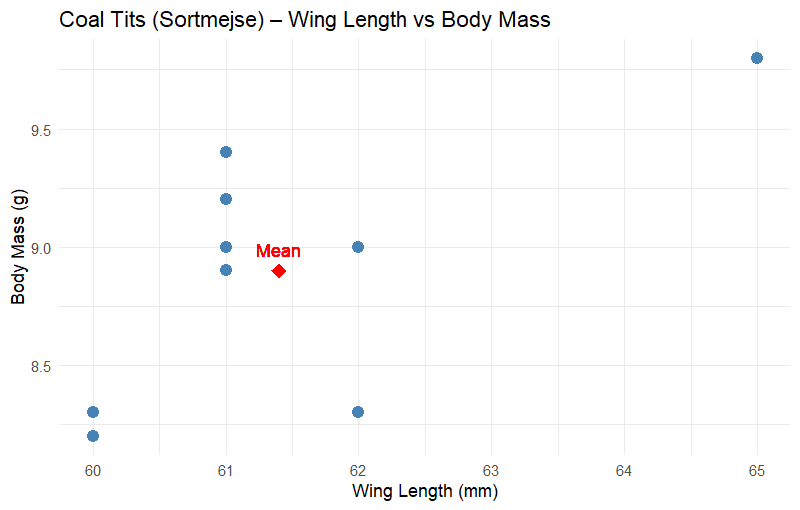 Wing Length (mm) and Body Mass (g) in the ten Coal Tits (Sortmejse) we ringed today.
Wing Length (mm) and Body Mass (g) in the ten Coal Tits (Sortmejse) we ringed today.
The counters had a relaxed morning out at World‘s End 3 with just a little migration but some fun birds. They got good views of a Velvet Scoter (Fløjlsand) – a new species for Sarah! At Grenen one Great White Egret (Sølvhejre) and even more surprisingly a Cuckoo (Gøg) made a migration attempt.
In the afternoon we prepared for nightcatching tonight. That included shopping, napping and finishing all other data tasks.
We just had a nice dinner by Rose and we are preparing now for nightcatching. I will update this during the night, so stay tuned.
Update: 00:36 am
This blog posts might be one of the most up-to-date ones, I‘ve ever written. That’s easily justified by the bird we just caught. Look at this beautiful (adult) Great Snipe (Tredækker)!
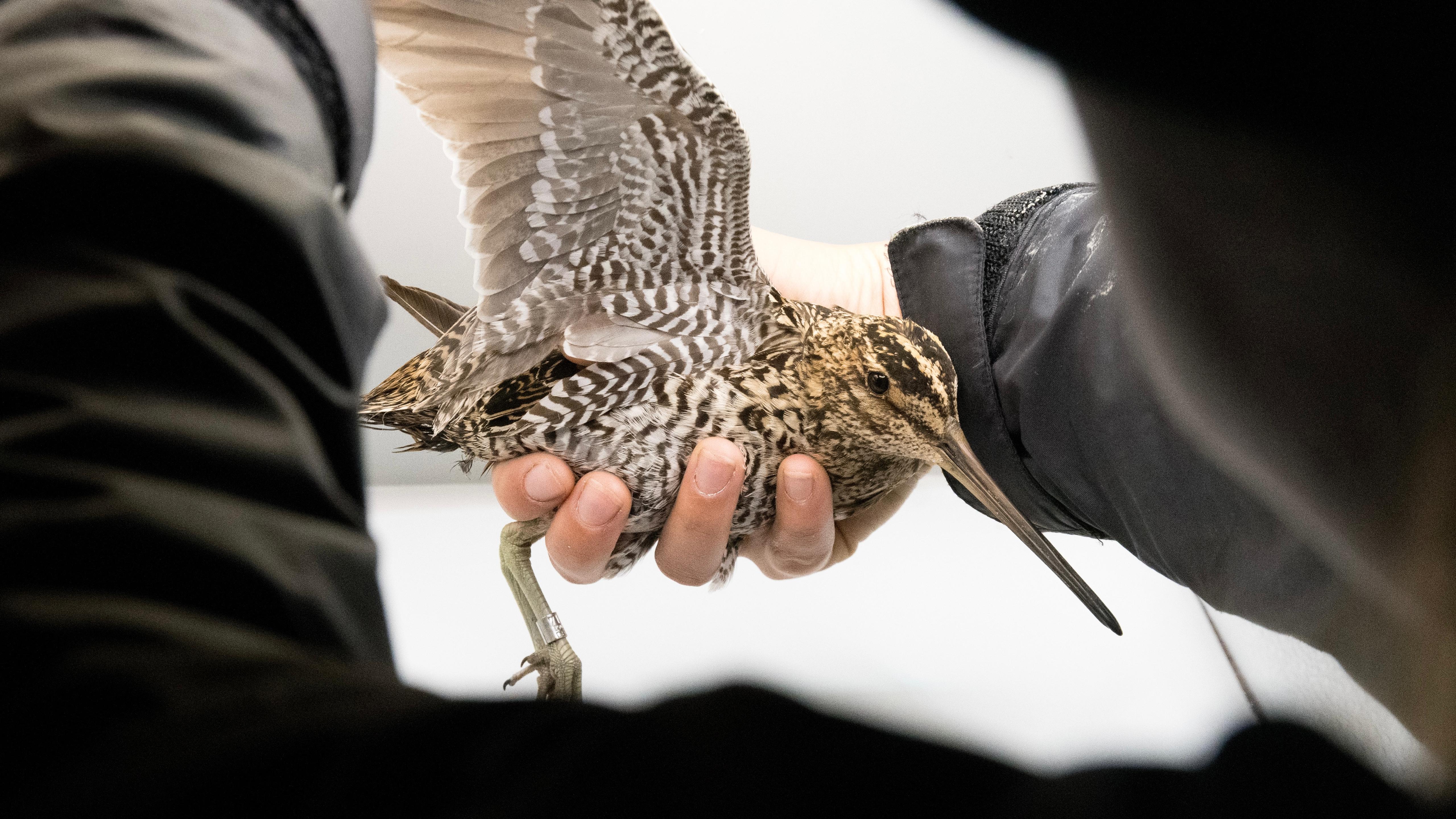 Streaked everywhere!
Streaked everywhere!
After passing by Saltum Strand, where we saw two Little Stints (Dværgryle), we headed towards Lerup Klit. Here we met Johan, who ringed quite some Snipes on these fields the past few years. When we went out of the cars we immediately heard the flight call of a Bittern (Rørdrum). After this good start we walked over the field. There were shooting starts and the calls of Red Deer. Then Johan spotted a Great Snipe (Tredækker) in the thermal and just a few seconds later it was in his hand. This bird was ringed by him three days (or nights) ago. It’s good to see it’s doing great and it gaines 5 g of weight in these days. With the for Great Snipes typical fat score of 9 (maximum) it felt like a small canon ball. Just soft and warm.
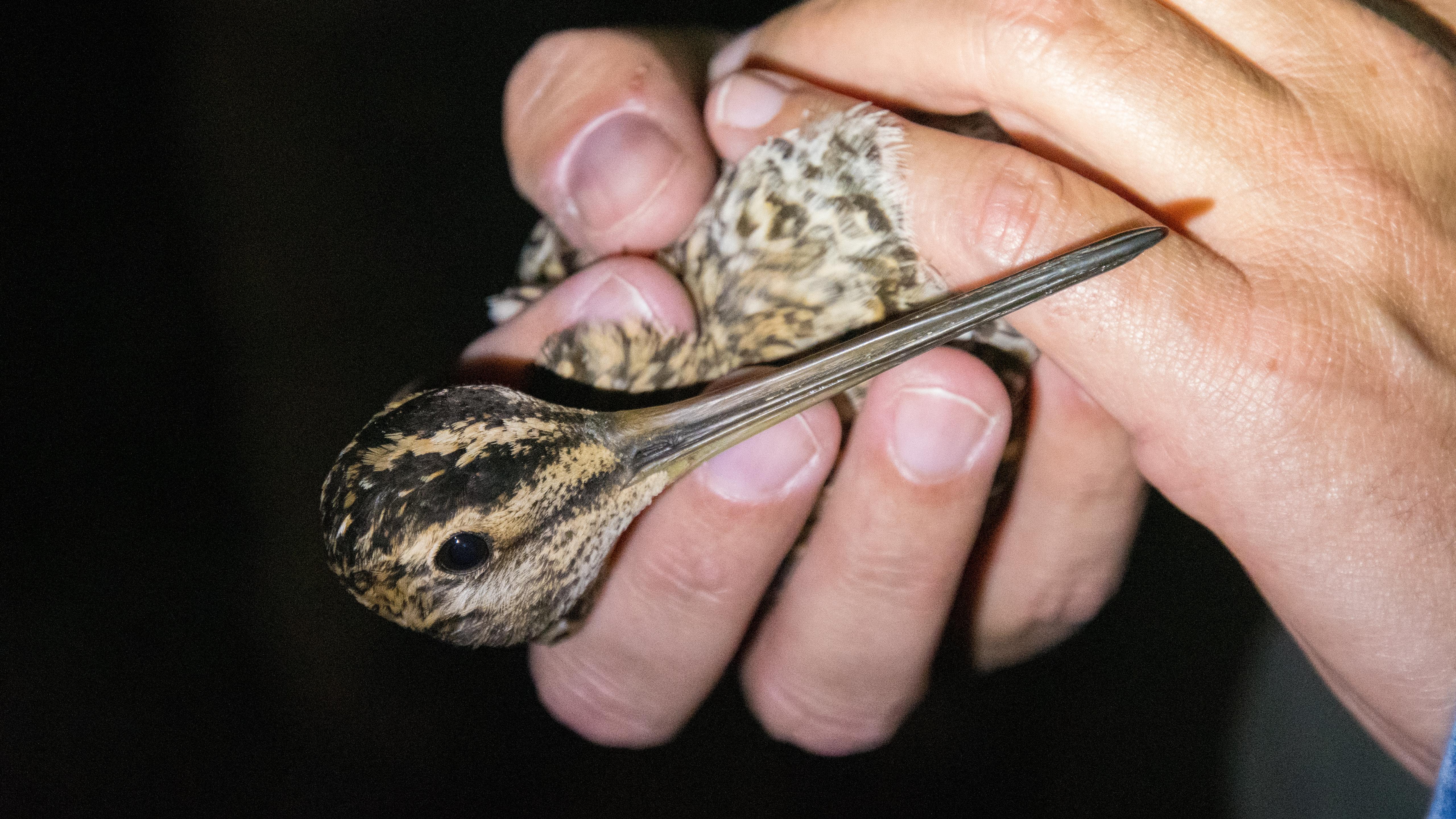
In total there were 5 Great Snipes on the field, but we‘ll try our luck on another field now. That means I‘ll have a short nap in SSC‘s car now to be fit for Kabeltromlen-ringing in just a few hours. Good night!
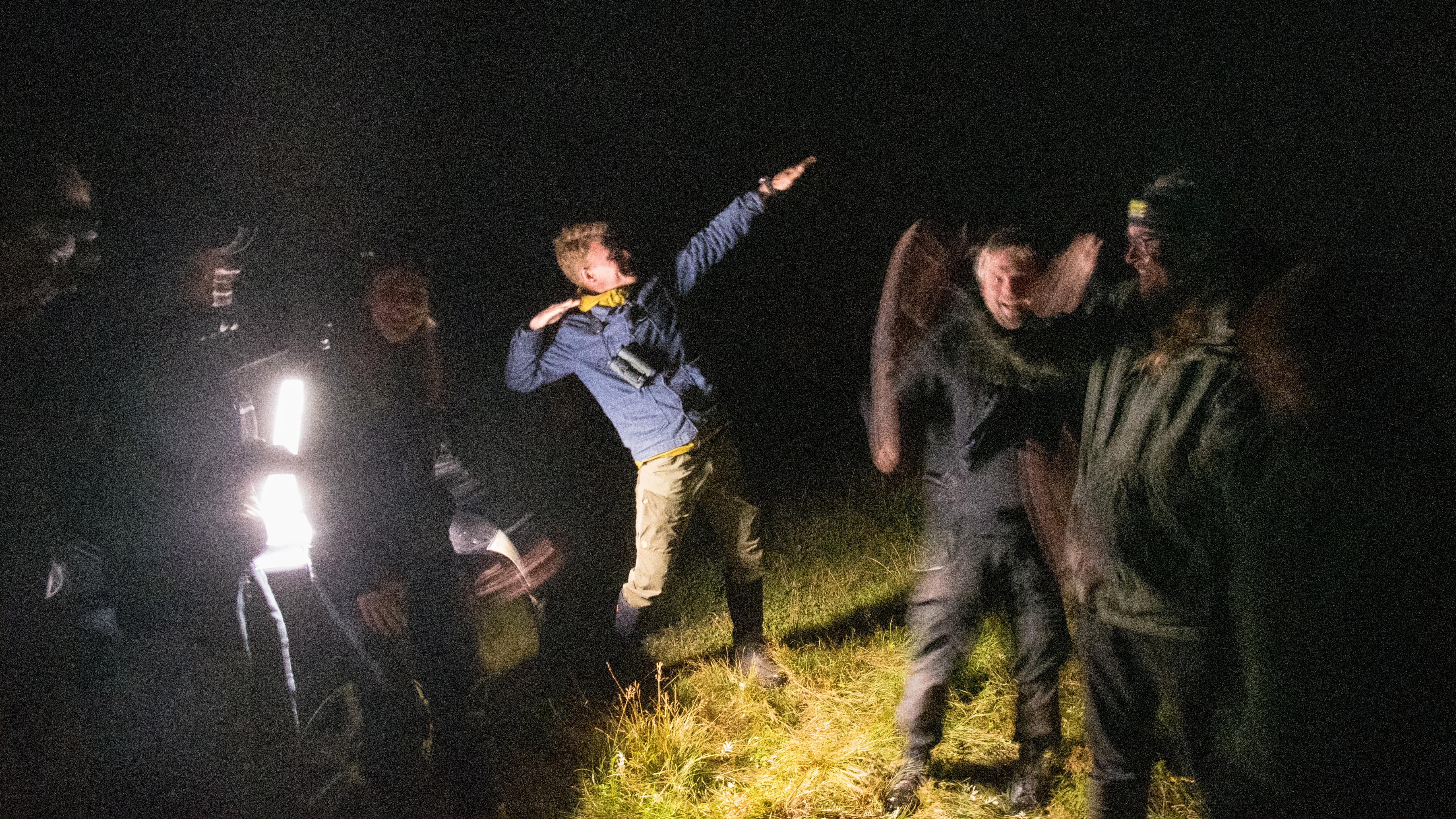 Happy night team.
Happy night team.
Chiffchaff (Gransanger) 3
Common Whitethroat (Tornsanger) 3
Garden Warbler (Havesanger) 1
Blackcap (Munk) 5
Coal Tit (Sortmejse) 10
Common Redstart (Rødstjert) 3
Reed Bunting (Rørspurv) 1
Reed Warbler (Rørsanger) 2
People: Rosemary Fricke, Markus Kemp Clément, Simon Kiesé, Louise Buksti-Ladefoged, Sarah Partridge, Cora Köberle, Simon S. Christiansen, Youri Van der Horst, Johan Funder, Morten Christensen and our guests Grete and Stig.
Sydlig Nattergal?!!!
This morning Louise, Makus and I went out to world’s end 3 to do the migration count. Later in the first round Knud joined us. It was warm out there and not windy at all. Due to the lack of wind there were also not many birds migrating on the Sea today. But we saw some smaller boats driving out. They were going to catch some Tunas to put Taggs on them for a research project. While scanning the inland we found a young Merlin (Dværgfalk) sitting on a pole in the dunes. That was the first one for this autumn here.
In the third hour there was almost nothing going on, so we decided to end early and spend the last hour looking at some color ringed Gulls on the beach.
On our way back we passed by the ringers at Kabeltromlen.
The ringers were joined by Juri and Simon Sr. today. They caught a good amount of birds today. One of them was a beautiful Redstart (Rødstjert). There were also around 70 Coal Tits (Sortmejse) flying over Kabeltrommel, we were lucky and caught three of them.
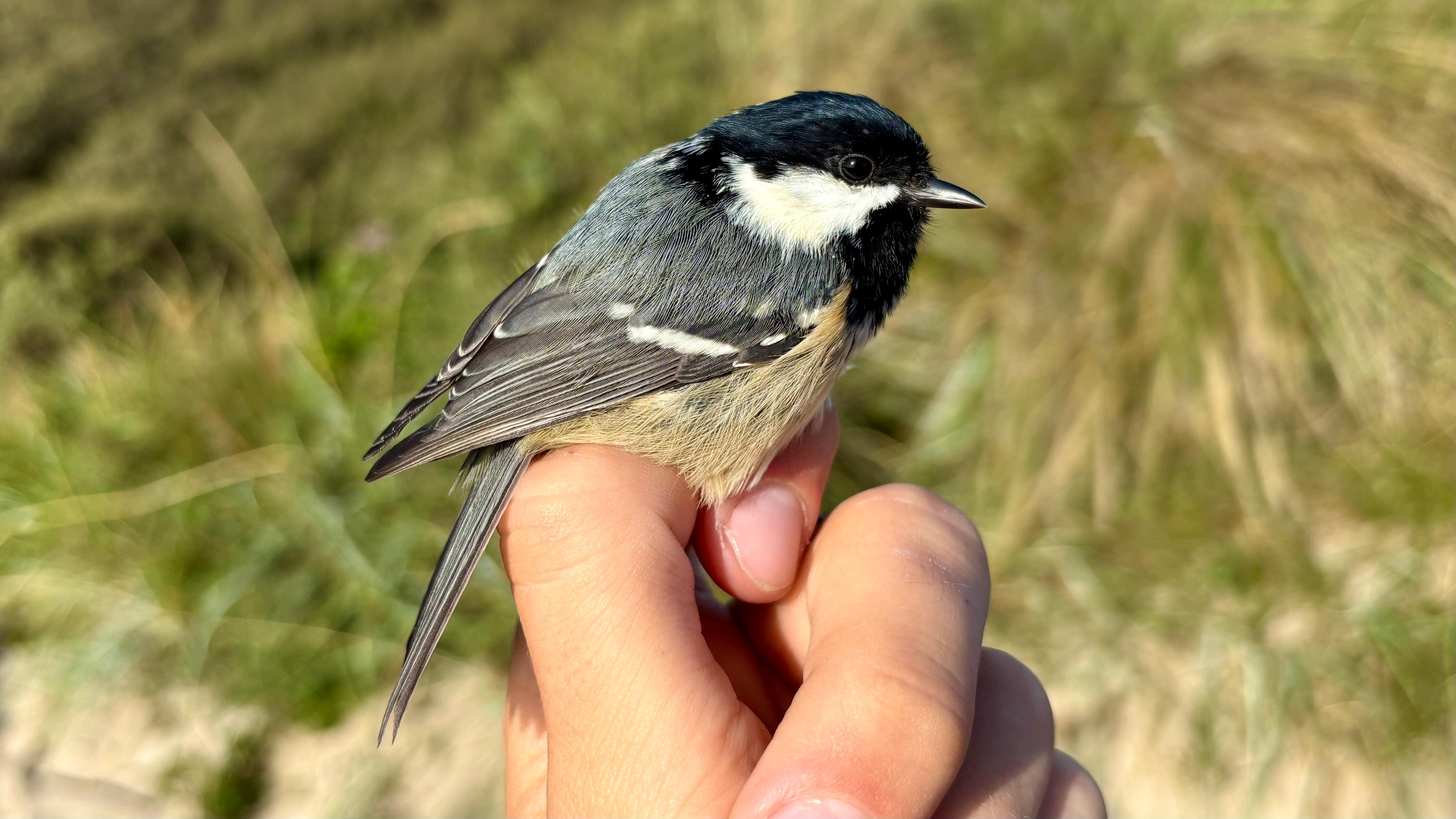
Coal Tit (Sortmejse)
In the last hour of ringing we were also able to observe many raptors flying over grenen. One of them was a Goshawk (Duehøg).
After having a little rest at the station Sarah, Louise and I went out to Skarvsøen to take down the Nets because the CES period is over. On our way there we saw many Adders (Hugorm) and Sand Lizards (Markfierben).
Back at the station Markus prepared us a delicious dinner and later we and the others put up the nets on the beach to try to catch Stormpetrels (Stormsvale).
We also had the Nightjar net opened. Simon and I went to check it. We were lucky, it had caught a 1cy. Nightjar (Natravn). But there was also a second bird in the net. were very surprised about it, it was a Common Nightingale (Sydlig Nattergal). Only the third ringed for the station and the 17th record for Skagen. As we announced it on Zello also Knud, Jørgen Kabel and Egon Østergaard and also Simon and Lisa came by to see it.
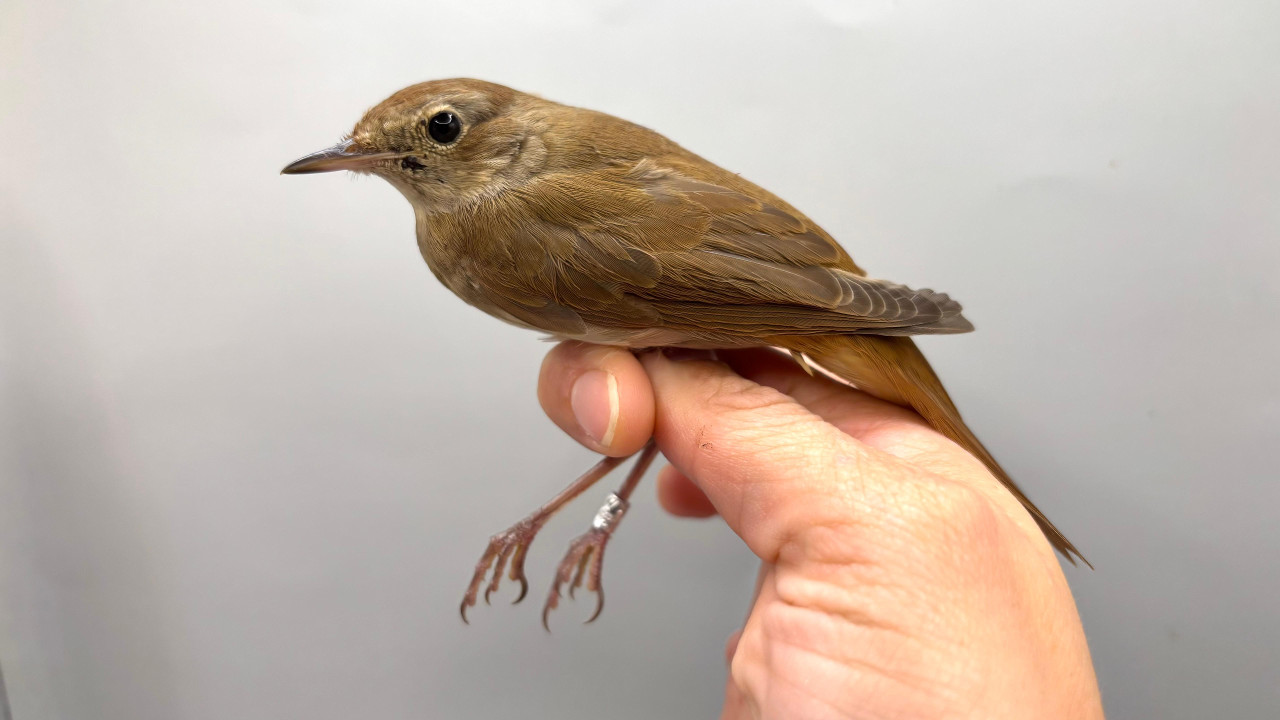 Common Nightingale (Sydlig Nattergal) - only the second autumn record in Skagen ever.
Common Nightingale (Sydlig Nattergal) - only the second autumn record in Skagen ever.

Common Nightingale (Sydlig Nattergal) and Nightjar (Natravn)
Ringing Kabeltromlen:
Munk 2
Gærdesanger 5
Tornsanger 9
Rørsanger 3
Løvsanger 7
Jernspurv 1
Rødhals 1
Sortmejse 3
Gransanger 4
Rørspurv 3
Lille Dompap 2
Kærsanger 3
Musvit 2
Rødstjert 1
Total: 47
Ringing Lighthouse Garden:
Sydlig Nattergal - 1
Natravn - 1
Highlight of the observations:
Merlin - Dværgfalk 1k
Today’s observations in Dofbasen from observers in the area
People: Rosemary Fricke, Markus Kemp Clément, Simon Kiesé, Louise Buksti-Ladefoged, Sarah Partridge, Cora Köberle, Simon S. Christiansen, Juri Van der Horst and our guests Grete and Stig.
Rain, Wind, and Reward
Last night Cora and Yuri was in charge of night catching. Unfortunately, luck was not on their side, and they had to close the nets at 02:30 due to rain. Markus and Yuri did spot two nightjars (natravne) near the nets, and Yuri almost managed to catch a skylark (sanglærke).
This morning, Simon and I opened the nets and had a pleasant start to the day with some good birds, including a spotted flycatcher (grå fluesnapper). Cora joined us for the third round, where we had six birds in the same net with, which included a bullfinch (dompap). We were also joined by our guests, Grete and Stig, who were happy to see the many birds they recognize from their garden up close. Unfortunately, the wind picked up, forcing us to close the nets earlier than planned.
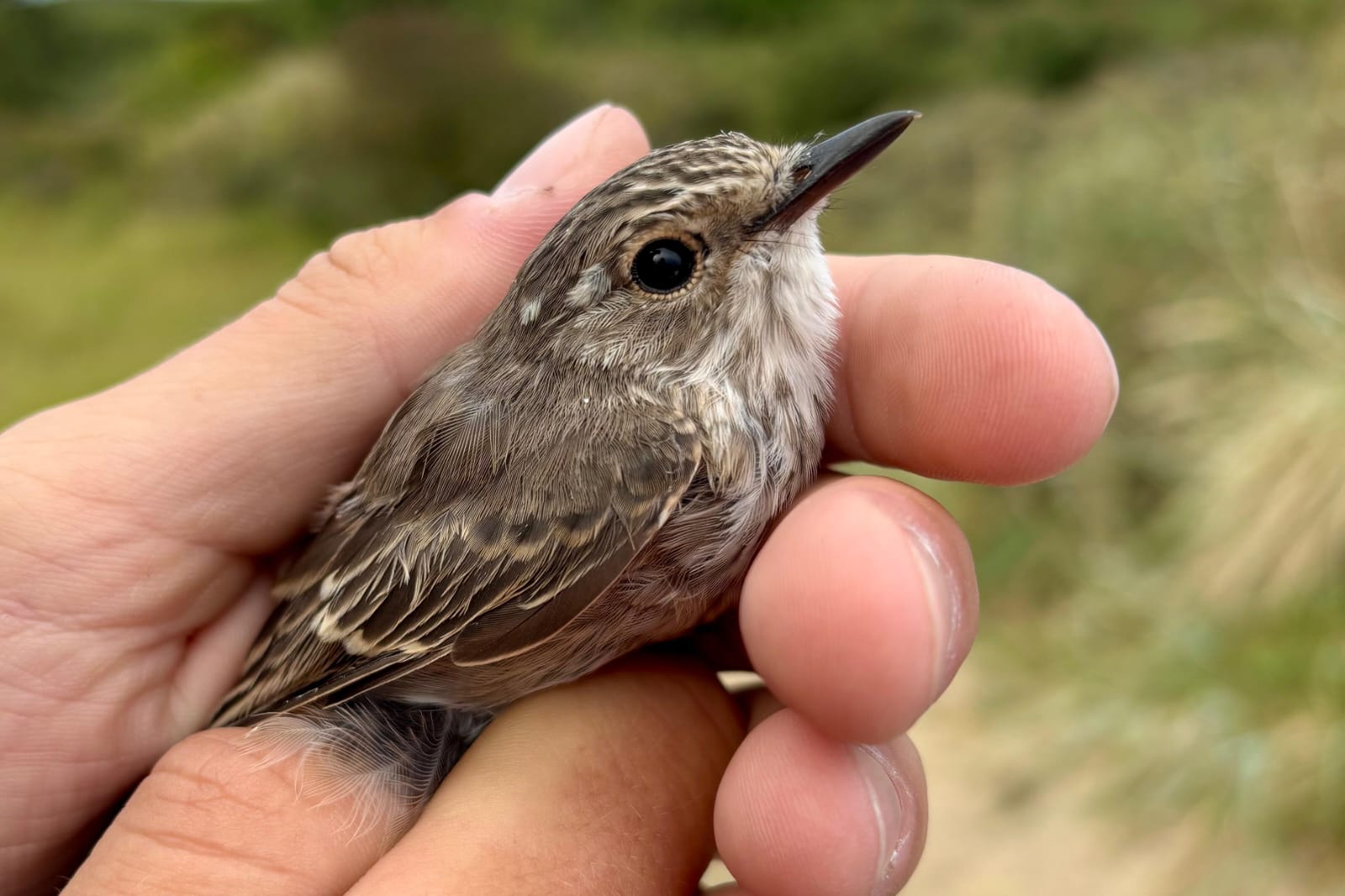
a beautiful little spotted flycatcher (grå fluesnapper)
Meanwhile, Markus and Sarah took care of morning observations at World’s end III. I was a calm and nice session, highlighted by an arctic skua (almindelig kjove) and some razorbills (alk) in the water, as well as some sanderlings (sandløbere) running around on the beach. The gull numbers were impressive. Amoun them, they counted a staggering 1679 resting herring gulls (sølvmåger)!
At midday, Sarah and Rose enjoyed lunch at Blink to celebrate Rose’s birthday yesterday. They highly recommended it for the rest of us. Later, Rose and Cora tested the thermal gear and even ventured to the attic in search of Fuglestationen merch. Even though they did not find any t-shirts or caps, they did find and bring back the day’s most unusual find: a plastic crab.
Grethe and Stig kindly returned with cake and homemade sea buckthorn/apple marmalade (a big thank you – I can’t wait the have some for breakfast tomorrow during morning observations).
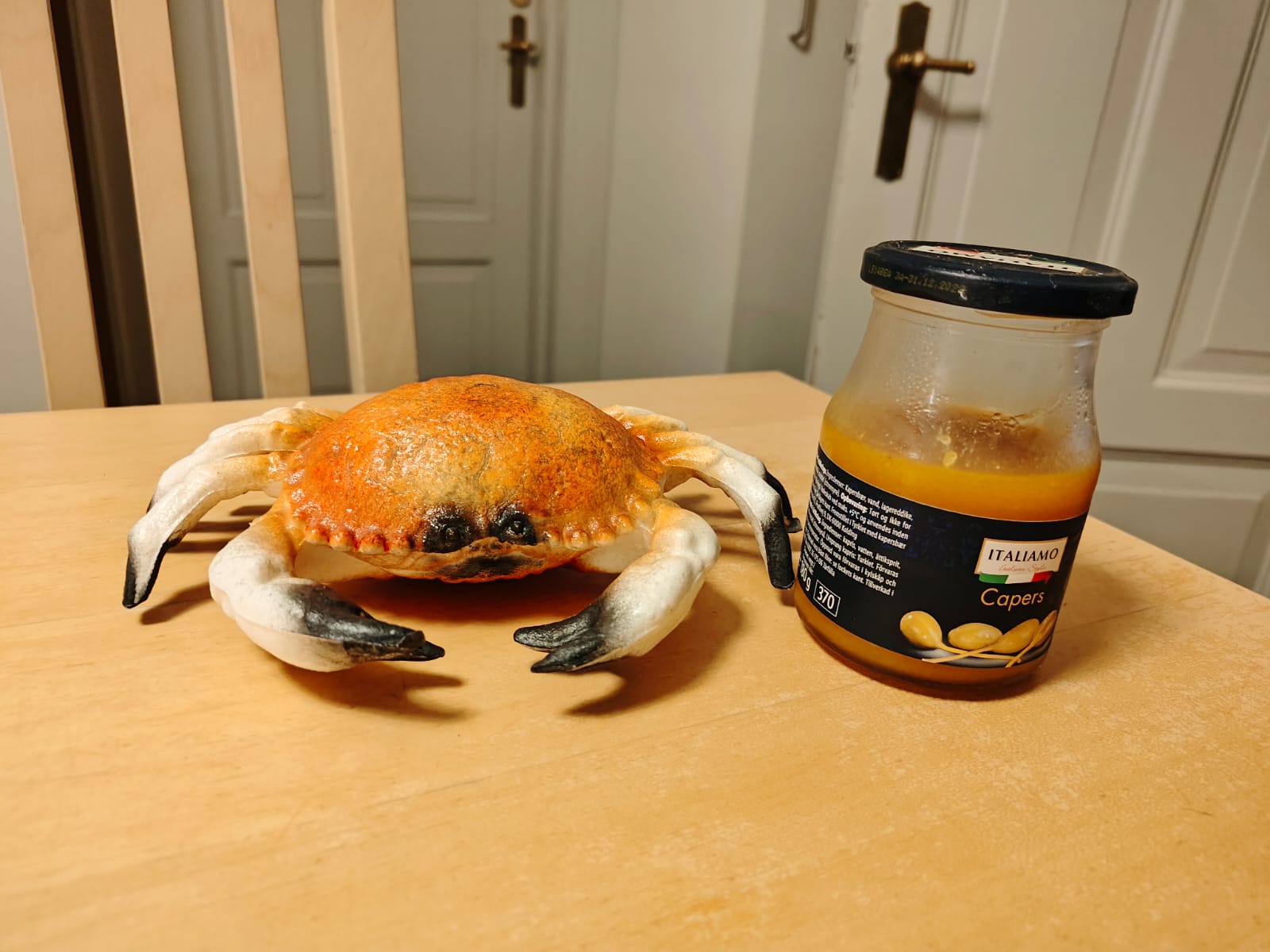
The attic crab and the homemade maramalade
Simon prepared an early and delicious dinner so that he, Markus, and Cora could head to Grenen for some evening birding. Their efforts were well rewarded with the sightings of a sooty shearwater (sodfarvet skråpe). What a spectacular way to round off the day!
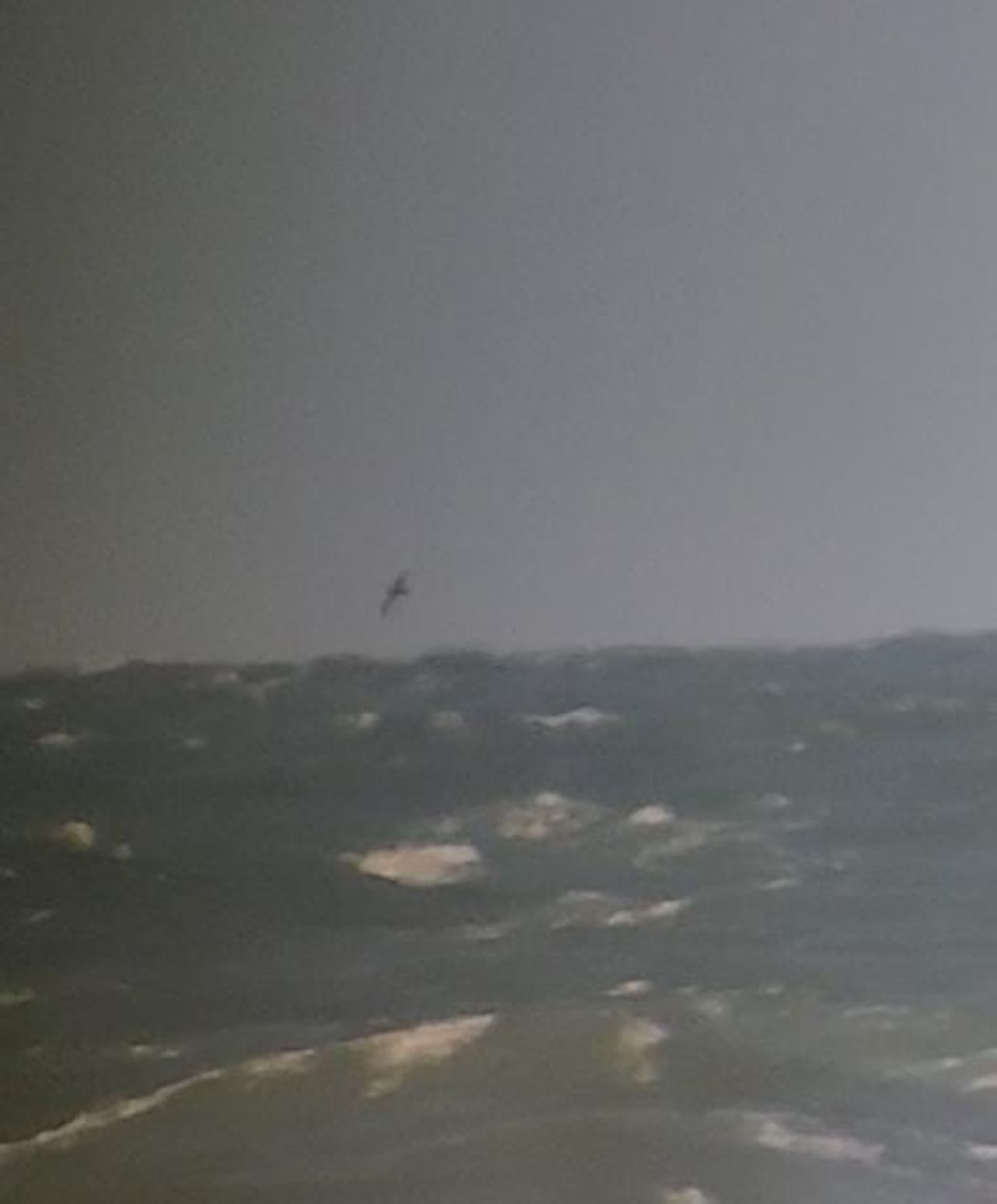
the sooty shearwater (sodfarvet skråpe).
Today’s observations by observers in the area of Skagen typed into DOFbasen can be found here.
Ringing at KAB:
2 Gærdesanger
1 Grå fluesnapper
1 Rørsanger
1 Blåmejse
3 Løversanger
2 Munk
1 Dompap
2 Gransanger
Total: 13
At the station:
Markus Kemp Clément, Simon Kiesé, Louise Buksti-Ladefoged, Sarah Partridge, Cora Köberle, Rosemary Fricke, Simon Sigaard Christiansen.
Årets første forsøg på at ringmærke Tredækker
Jeg vil ligge ud med at gribe pennen, hvor Rose efterlod den da vi skulle til at drage sydpå i forsøget på at ringmærke Tredækkere i går nat.
Vi var så heldige at have selskab af Knud og Lars Bo, hvilket betød at alle på stationen havde muligheden for at tage med. Inden mørket havde sænket sig helt, aflagde vi et besøg hos Simons far, hvor vi fik en særdeles fornem behandling, med kaffe og kage. Det var superhyggeligt, og skønt med et ekstra skud energi inden vi skulle trampe græsmarker natten igennem.
På Skagen Fuglestation anvender vi vores termiske kikkert til at spotte rastende fugle, for derefter at snige os nærmere og fange dem med et håndnet.
Volsted Kær var første target-område. Vi brugte et par timer her, desværre uden held. Bedste fugl her var en Dobbeltbekkasin. De er mere årvågne end Tredækkerne, hvorfor de kan være besværlige at komme helt tæt på.
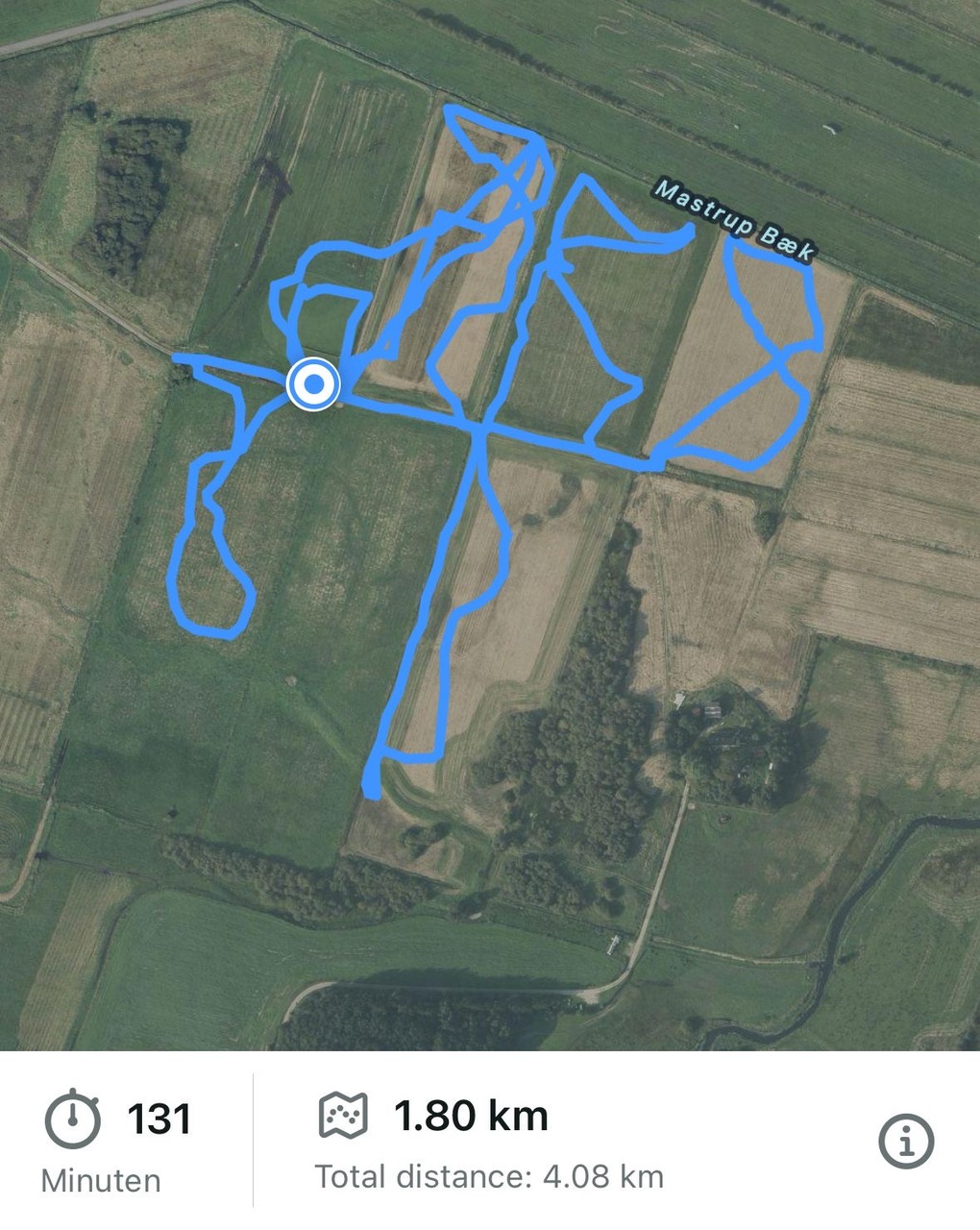 Vi gik i hvertfald ikke et lige transekt henover markerne!
Vi gik i hvertfald ikke et lige transekt henover markerne!
Vores andet målområde var en mark i Lindenborg. Det var en af efterårets første rigtig kolde nætter, med en temperatur mellem 5-7 grader i disse rurale områder. Kulden var derfor så småt begyndt at snige sig ind på os, og det var ikke alle der gik med til den fjerneste ende af marken. Her fandt vi dog et område der skilte sig ud ved at være en smule fugtigere end resten af marken. Pludselig var der mange Dobbeltbekkasiner (omkring 15-20 stk.). De var dog ikke helt lette at komme tæt på. Simon gik forrest med den termiske kikkert, jeg fulgte trop med nettet.
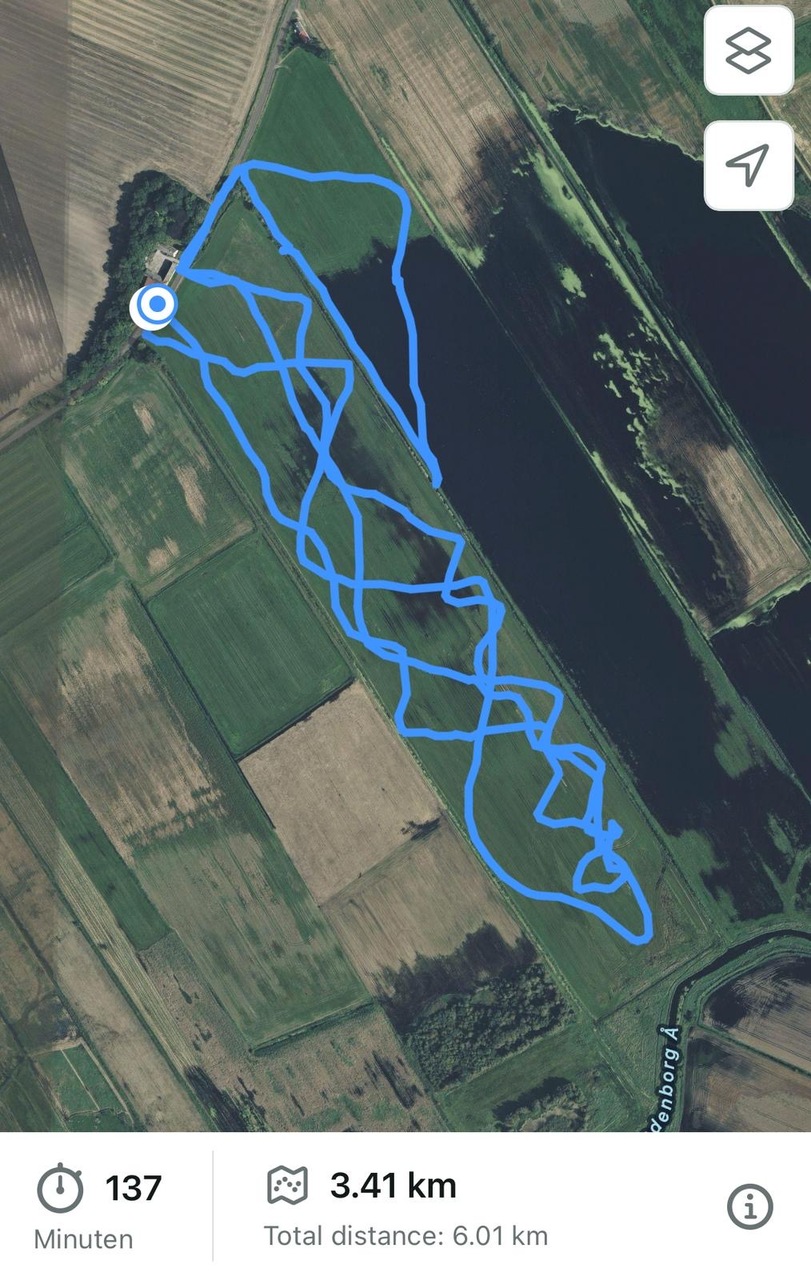 Gåruten på marken ved Lindenborg.
Gåruten på marken ved Lindenborg.
På kanten af det fugtige område fandt Simon en fugl, der ikke fløj op med det samme. Vi sneg os tættere på, men kiksede en smule med den lygte der skulle blænde fuglen og lade os komme på fangsthold. Derfor lettede fuglen på nogle meters afstand. Den var stor og tung, og kaldte ikke som Dobbeltbekkasinerne. Det var en Tredækker.. Øv, vi kiksede at fange den, men hey, de er her altså! Troen på succes blussede op, og varmen spredte sig atter i kroppen. Senere på natten fandt vi endnu en fugl der trykkede sig i græsset. Denne gang nåede vi så langt som til blot at mangle et sølle skridt, før jeg ville gøre udfaldet med nettet. Fuglen lettede dog, og igen var det en tung sneppe. Vi fandt ikke flere Tredækkere i løbet af resten af natten, hvorfor vi i denne omgang måtte vende snuden hjemad mod Det Grå Fyr uden at have ringmærket en Tredækker.
Da vi efter en halvanden times kørsel nåede tilbage til toppen af Danmark var det første lys så småt på vej. Louise, der ikke havde været med sydpå, drog ud for at åbne nettene ved Kabeltromlen. Vi andre kunne lige nå en powernap på 30-40 min. Inden første netrunde omkring kl. 6.
På de første par runder var der sandelig fugle i nettene, med 25-30 fugle i den ene runde. Herefter stagnerede aktiviteten dog. Vi havde blandt andet selskab af Yuri, der har ringmærket meget i Holland.
Sarah og Cora stod for morgenobsen. De havde en del vadefugle, men manglende vid betød at der ikke var stor aktivitet til havs.
Vi havde alle en del søvn at indhente fra den forgangne nat, hvorfor der ikke var megen aktivitet på stationen i løbet af formiddagen og eftermiddagen.
Rose har fødselsdag i dag. Derfor spiste vi efter den fælles middagslur en lækker Cheesecake, og indviede vores internationale frivillige i en af de klassiske danske fødselsdagssange – den med instrumenterne :D Rose kunne frit vælge tre instrumenter. Vi endte med at spille på Valdhorn, Didgeridoo og Kain. De instrumenter har jeg trods alt ikke spillet på før.
Jeg har netop slået vores net op til at fange Natravne, imens nogle af de andre har rigget vores Stormsvale net op på stranden. Fingers crossed for at der er succes i dag.
Highlights Observations:
2 Tredækkere ved Lindenborg
Today’s observations by observers in the area of Skagen typed into DOFbasen can be found here.
Ringing Kabeltromlen:
Fuglekonge 2
Gransanger 9
Rørspurv 6
Havesanger 1
Munk 5
Tornsanger 13
Rørsanger 2
Gærdesmutte
Grå Fluesnapper 1
Kærsanger 1
Rødhals 1
Løvsanger 3
Total 45
At the station:
Markus Kemp Clément, Simon Kiesé, Louise Buksti-Ladefoged, Sarah Partridge, Cora Köberle, Rosemary Fricke, Simon Sigaard Christiansen.
Konge visits the observatory!
A short recap today as we will soon be leaving to go to … tonight in our first attempt of the season to ring Great Snipe (Tredækker)!
It will be the second night shift in a row for me, as last night I was up for another try at attracting Storm Petrels (Stormsvale) and Nightjars (Natravn). We had a very early juvenile Nightjar, but other than that it was a quiet and clear night, and I was joined for most of it with visitor Julius (thanks for your company!)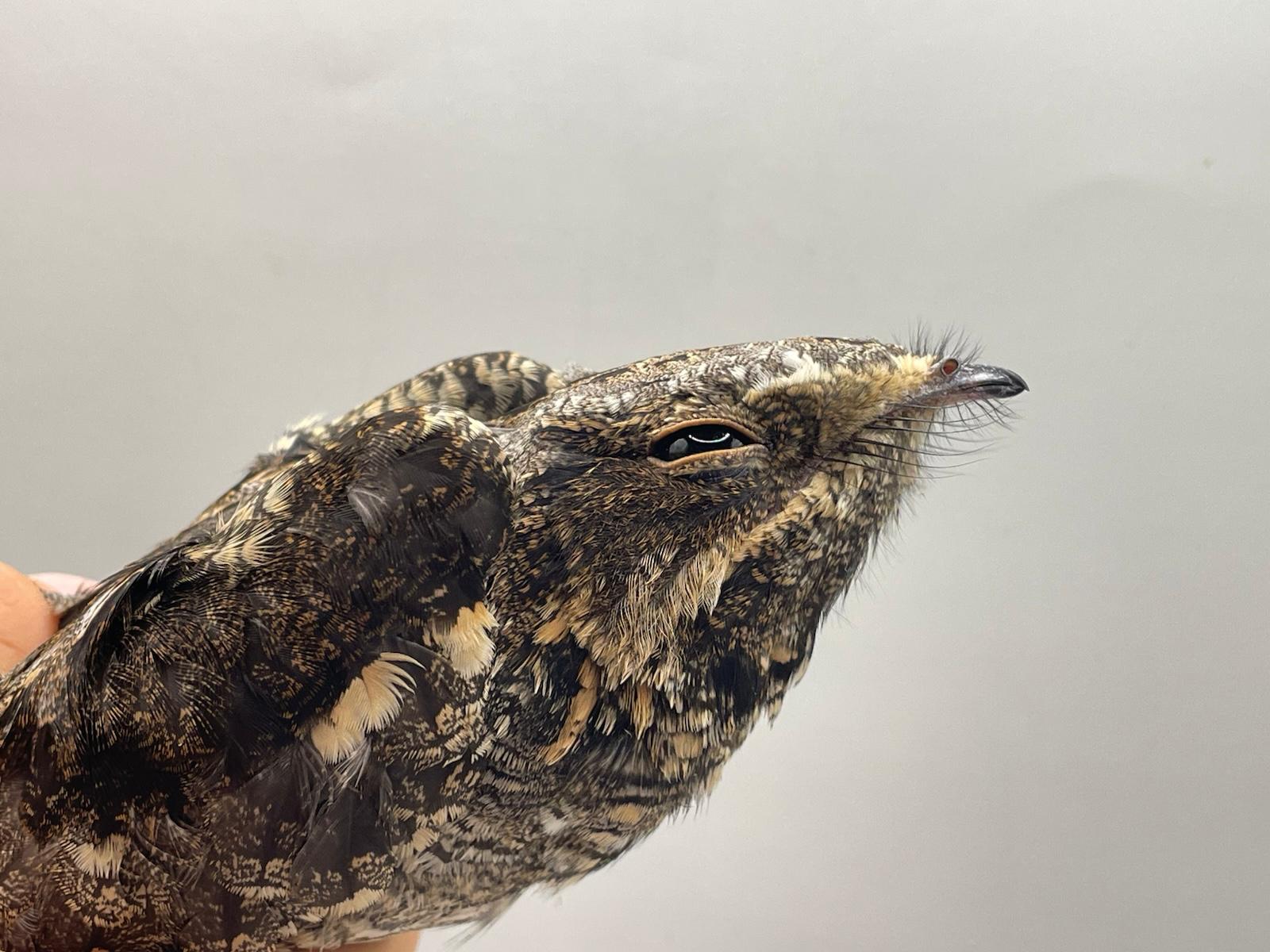
Natravn 1K
While I slept in this morning the others were busy as usual. Sarah and Louise went to World’s End III for observations. With a calm sea there was not much activity in the way of seabirds, but they had a nice selection of wader flocks coming through, and individual Golden Plover (Hjejle) and Redshank (Rødben). A Great Spotted Woodpecker (Stor Flagpætte) also came by for a rest.
Today was also the final CES visit to Skarvsøen for the season. Led today by Simon, Cora and Markus, and joined by Julius, they caught a whopping 72 new birds today, the majority of which (32) were Reed Warblers (Rørsanger). Also, overhead they were graced with a Goshawk (Duehøg), Coal Tits (Sortmejse), and Common Snipes (Dobbeltbekkasin), as well as Bearded Tits (Skægmejse) in the netting area.
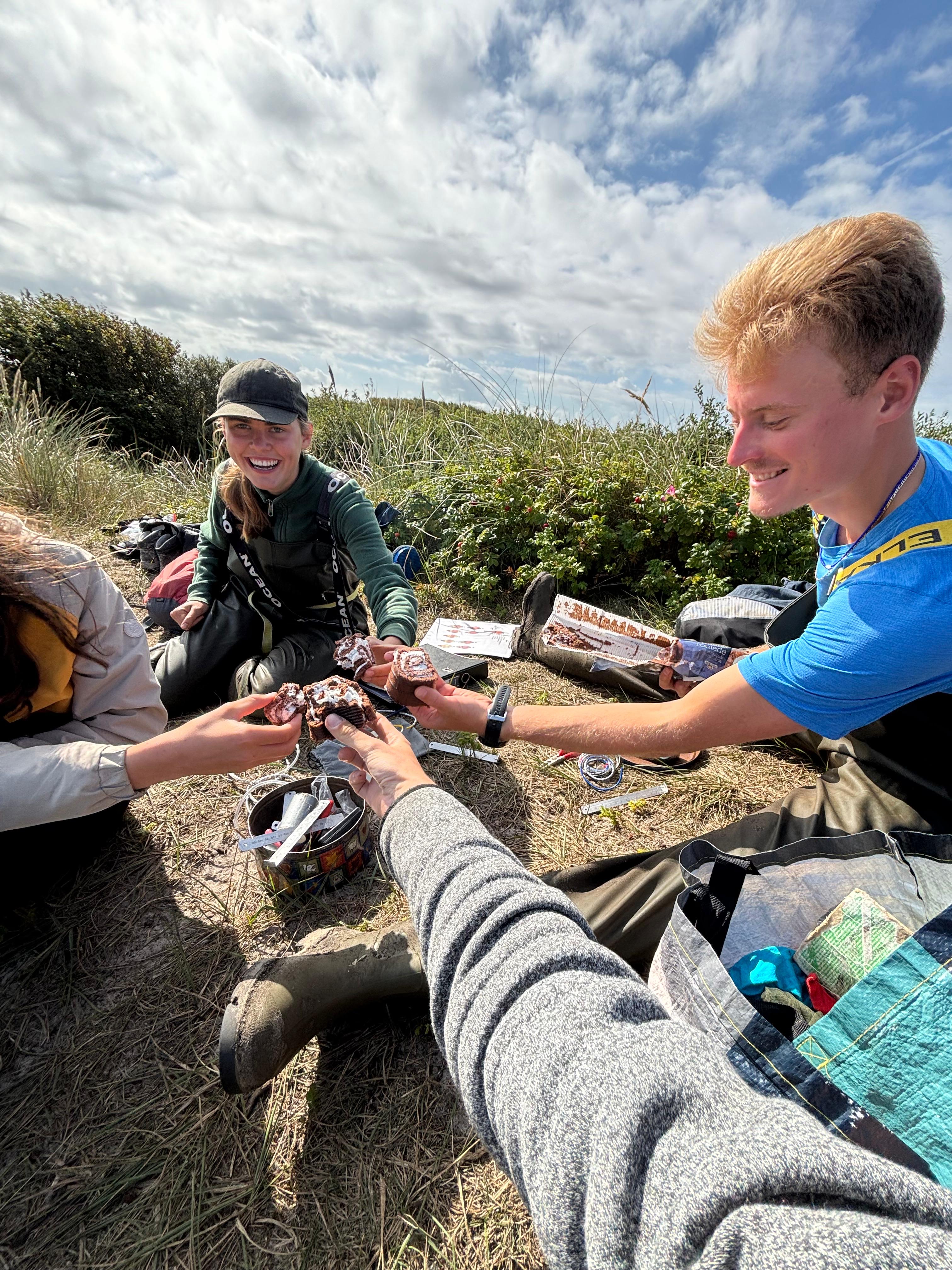
Whats better than this? Cake and birds at the CES!
No rest for the wicked today though as we spent time after work to prepare for a potential royal visit from the King of Denmark (otherwise known as Fred) to our apartment’s premium lavatory suite. Alas, his toilet break was abandoned, which is more unfortunate for him since the team caught a Goldcrest (Fuglekonge, i.e. “King of the birds”) in the garden net this afternoon instead - close enough, eh?
Now for a little nap for some and a dinner fit for a king (thanks Sarah), before heading out to Volsted shortly!
All observations for the area can be seen in DOFBasen.
Ringing totals CES:
Rørsanger 32
Gransanger 11
Løvsanger 3
Solsort 2
Rødhals 1
Munk 7
Gulbug 2
Tornsanger 5
Blåmejse 2
Gærdesanger 4
Rørspurv 2
Bogfinke 1
Total: 72
Highlights at Skarvsøen:
Goshawk - Duehøg
Bearded Tits - Skægmejse
Highlights at World’s End III:
Golden Plover – Hjejle
Redshank – Rødben
People at the station:
Markus Kemp Clément, Rosemary Fricke, Simon Kiesé, Louise Buksti-Ladefoged, Sarah Fartridge, Cora Köberle, Lars Bo Jacobsen, Simon S. Christiansen.
Sanity Sunday
Today was a fairly sane Sunday for Skagen Fuglestation. I started the day opening nets at Kabletromeln with Simon, and then Cora joined us for the first round. It was a steady stream of birds today with four or five in the nets at every round, with a good range of species. I was pleased to see two Muskvit and always very excited to see the Fuglekonge. The closing round brought a highlight for everyone with one very sweet Træløber. There were few quiet moments between ringing but Cora managed to find time to capture several sand lizards (Markfirben) that we admired together. There was one Stor Flagspætte flying around but despite Cora’s encouragement did not want to come down into the nets. We also saw some Redpolls (Gråsisken), Linnets (Tornirisk), and a couple of Whimbrels (Småspove) flying overhead.
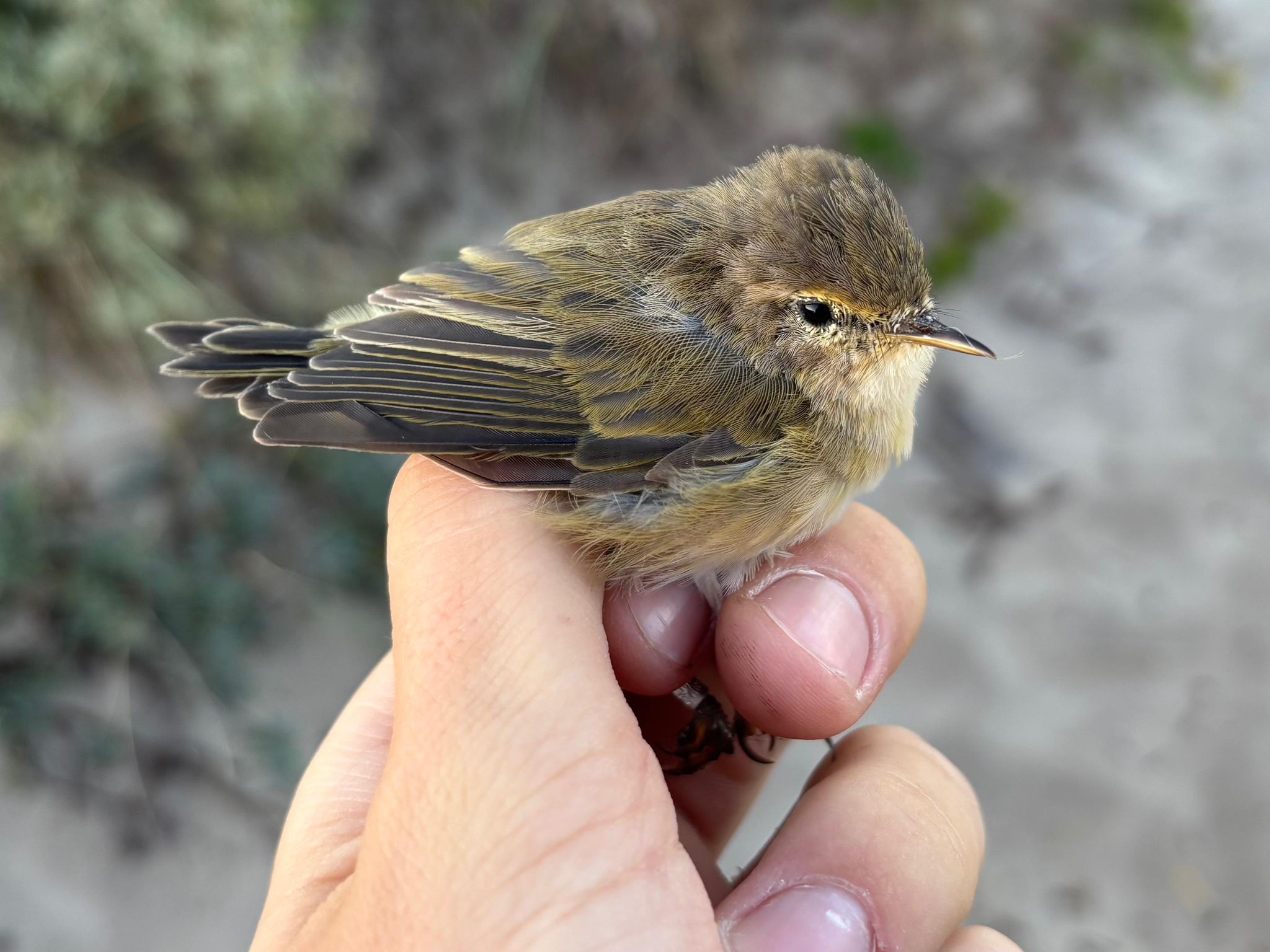
A Handsome young Gransanger
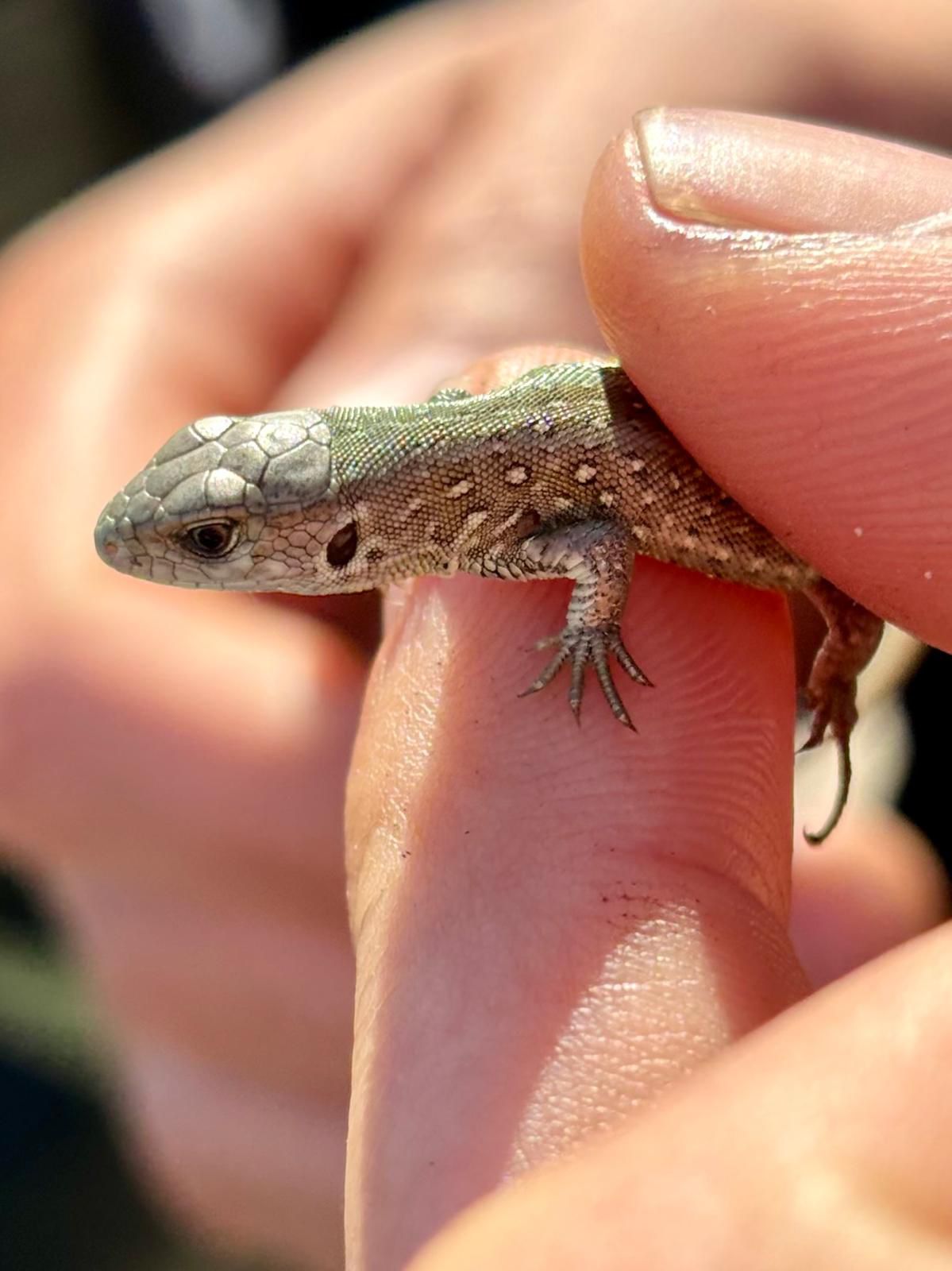
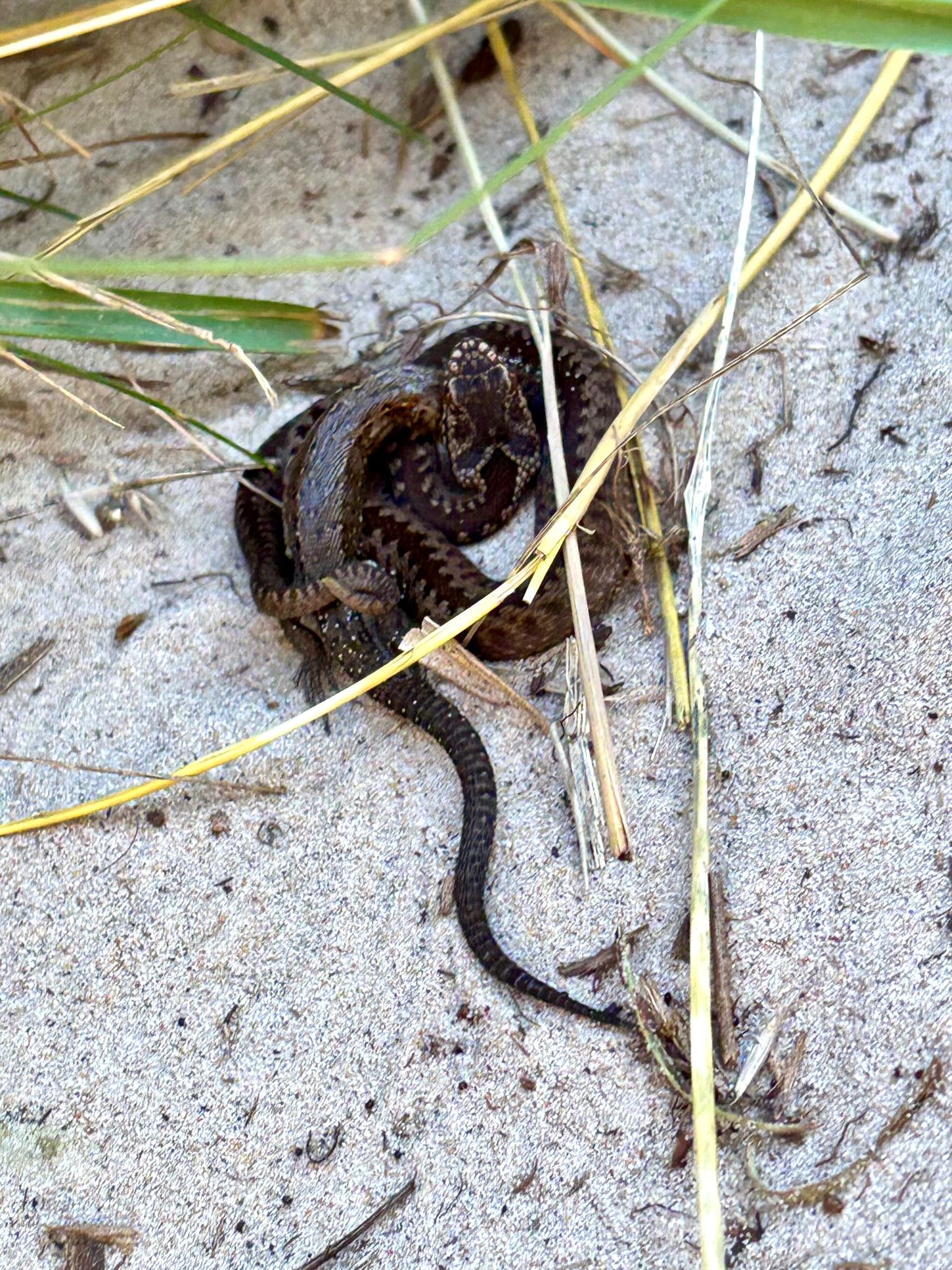
An adder feasting on a sand lizard
Rosemary and Markus went to Wrold’s End 3 for observing, enjoying a luxurious lie-in with the later sunrise of 05:59. There they did not see any rarities or much migration, but had a nice time counting the regular suspects and saw one arctic skua (Almindelig Kjove), which we were also able to see from Kabletromeln. Rosemary joined us for the last couple of rounds of ringing, and Markus stopped by after a chat with Eric. Louise did not join us today as she was at the wedding of her best friend, which she greatly enjoyed.
After a swim and lunch together, we all had naps this afternoon to stockpile some sleep for the next couple of nights out ringing.
Ringing Totals:
Solsort 1
Musvit 2
Løvsanger 6
Gærdesanger 2
Rødstjert 1
Jernspurv 1
Rørsanger 1
Tornsanger 9
Munk 8
Rørspurv 1
Dompap 1
Gransanger 9
Træløber 1
Total 44
Highlights:
Whimbrel (Småspove)
Arctic skua (Almindelig Kjove)
Today's observations from observers in the area can be found here.
People: Markus Kemp Clément, Rosemary Freaky, Simon Kiesé, Louise Buksti-Ladefoged, Sarah Partridge, Cora Köberle, Lars Bo Jacobsen, Eric Christophersen.
Long legs, long bills
Last night we went to Jerup, a place half an hour south of Skagen, to try to catch and ring some waders. Luckily, Lars took most of us including the equipment with him in his car. Rose and I took the train, so we met around 11 pm at the beach. There was a thunderstorm over the Kattegat giving the night a nice atmosphere. When the nets were set up, we walked along the beach and I spotted birds in the thermal. It did not take long until this beautiful Oystercatcher (Strandskade) was under Cora’s hand net. We measured it, it got a shiny ring and we released it soon after.
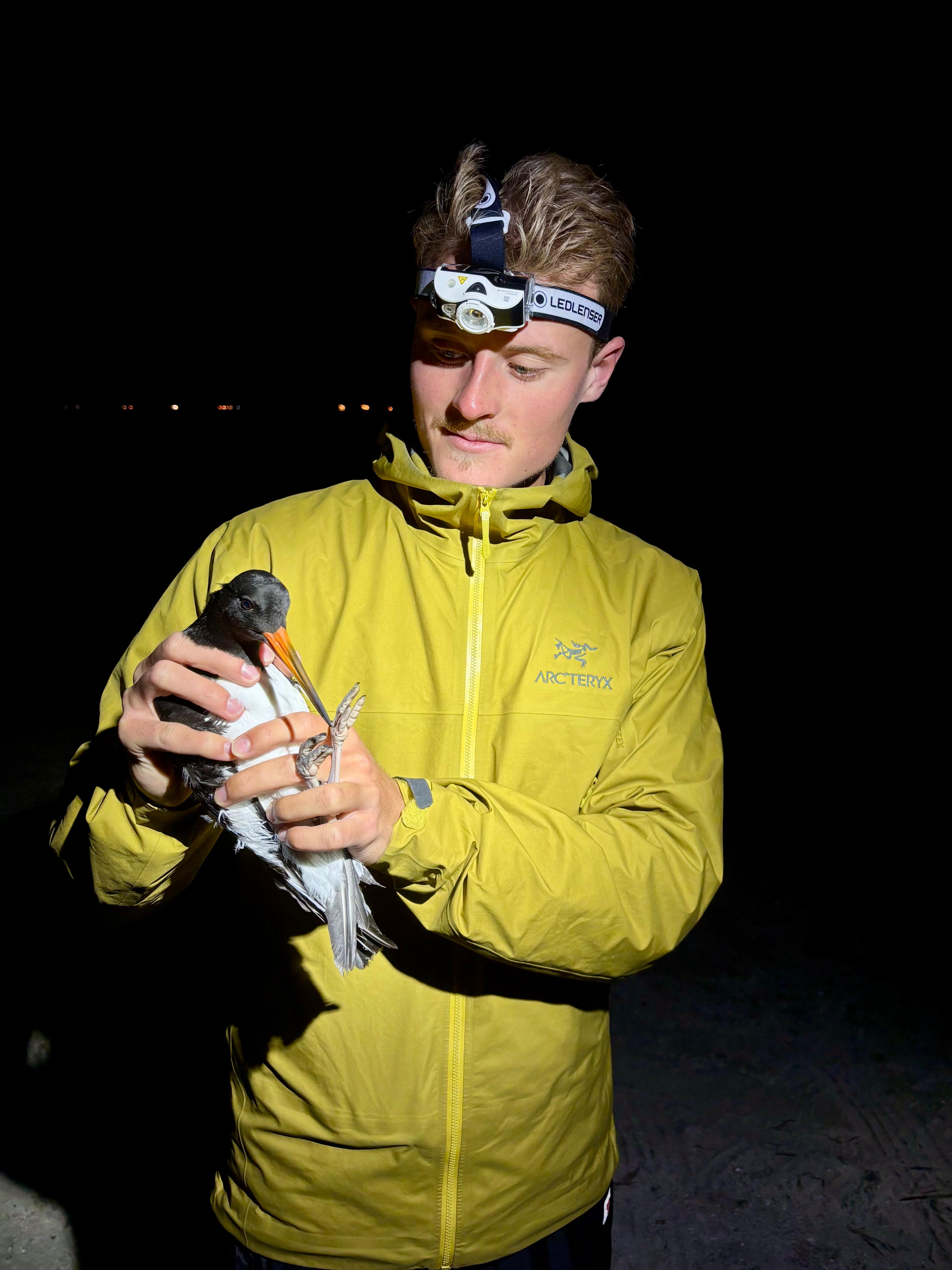 Markus having the Oystercatcher (Strandskade) under control.
Markus having the Oystercatcher (Strandskade) under control.
In the next round we got pretty close to a Greenshank (Hvidklire), but it walked so quickly, that we could barely keep up. A Redshank (Rødben) was more relaxed, so we took the opportunity to grab it. A new species in hand for most of us!
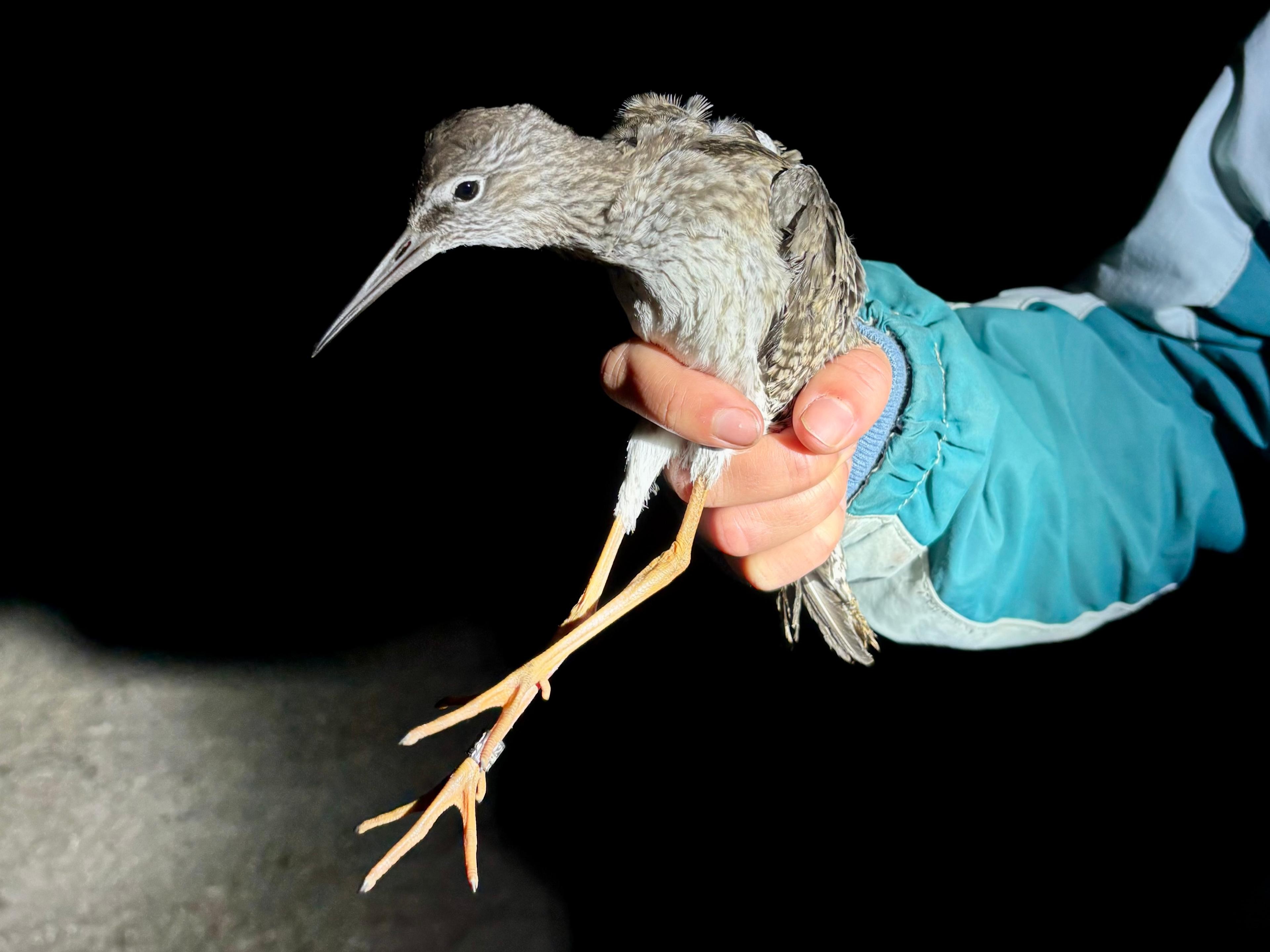 Long red legs: not the only feature to identify a Redshank (Rødben).
Long red legs: not the only feature to identify a Redshank (Rødben).
One more: this young Red Knot (Islandsk Ryle) was the third wader species tonight. 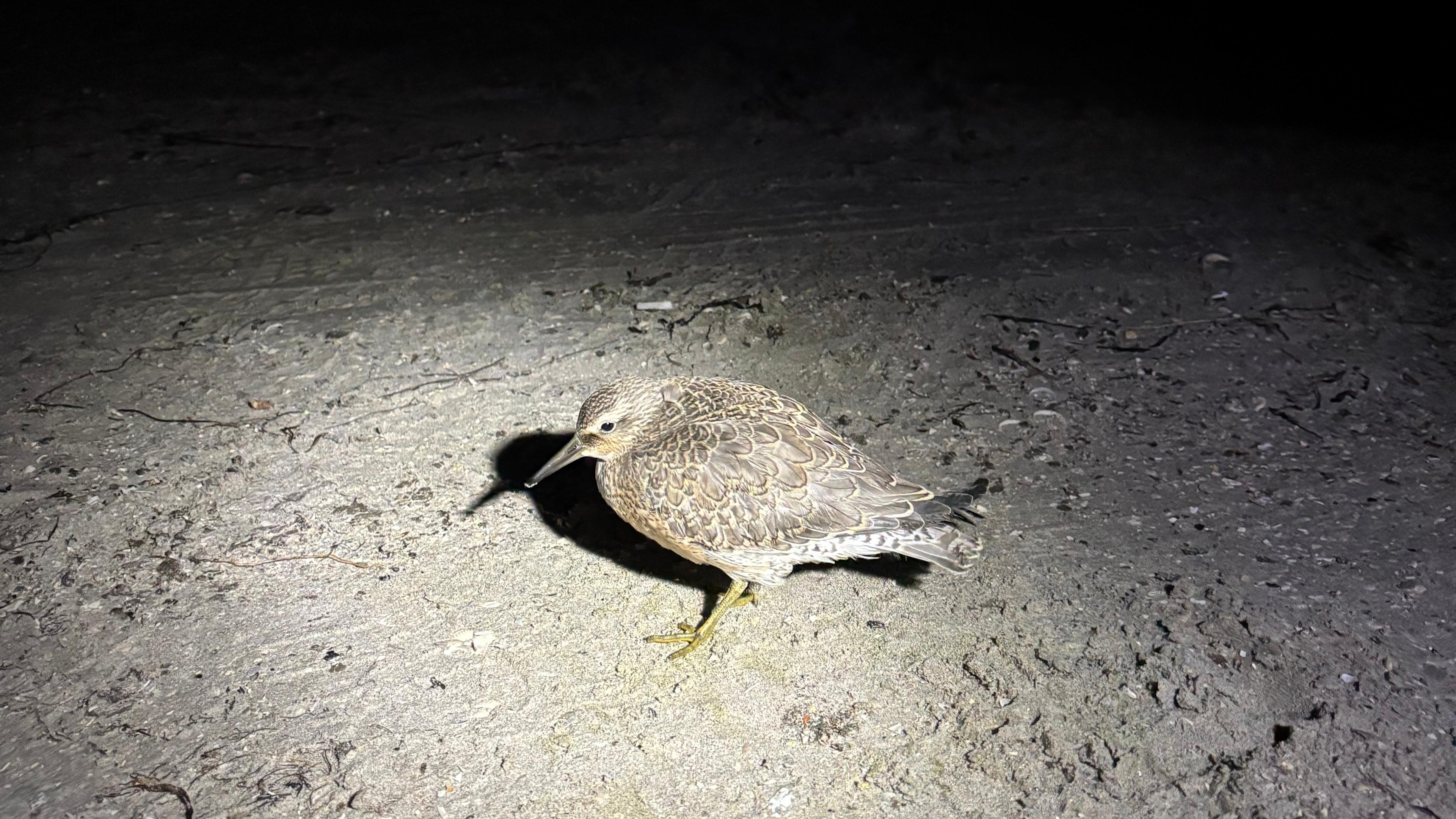 Super cute Red Knot (Islandsk Ryle) accepting us as his friends.
Super cute Red Knot (Islandsk Ryle) accepting us as his friends.
The wind picked up, so we had to take down our wader net. Fortunately, there was one more Redshank (Rødben) and Red Knot (Islandsk Ryle). What a nice night!
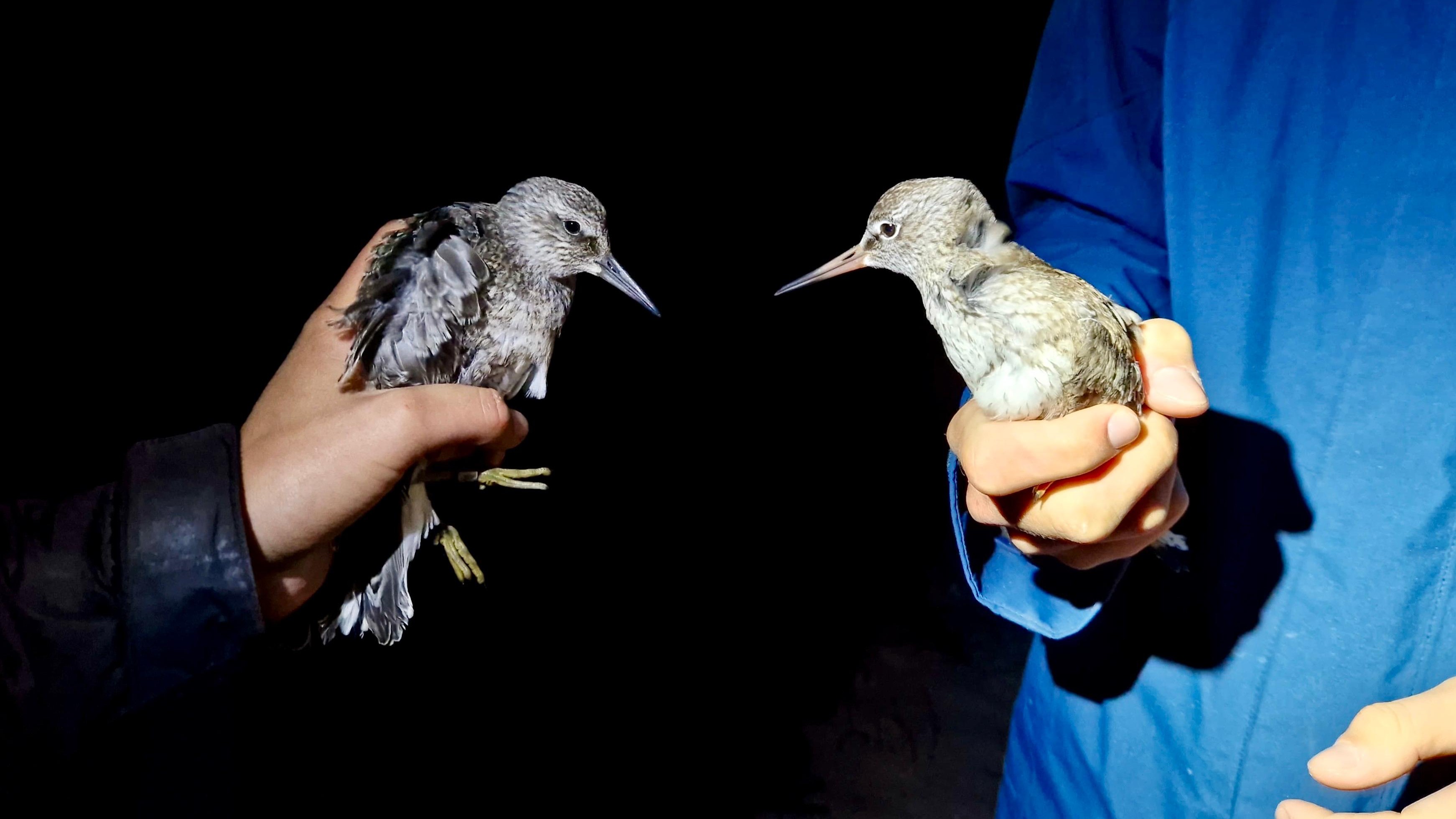 Kindergarden: young Red Knot (Islandsk Ryle) on the left and young Redshank (Rødben) on the right.
Kindergarden: young Red Knot (Islandsk Ryle) on the left and young Redshank (Rødben) on the right.
Back at the station, I really appreciated the long nap. It was very windy, so we could not open our nets at Kabeltromlen. Standing the storm, Sarah and Markus headed out to WE3. The northerly winds killed migration once more, but the birds that fly in this wind are good ones. It started with a Manx Shearwater (Almindelig Skråpe) which came in a nice distance, always a great bird. Even though the observation was a bit more tricky, the next bird was even better: a Sabine’s Gull (Sabinemåge) headed northwest. Markus made a nice drawing of it documenting the most important features – congrats!
After waking up, Cora and I started packing the nightcatching stuff back in order. We also opened the net in our garden, when suddenly Johanna and MHL (Magnus) showed up. It was very nice to see them again and we had a nice chat. Then we also caught a House Sparrow (Gråspurv) and a Tree Sparrow (Skovspurv). It was the first bird ringed by Magnus since spring 2024 at the station, but his measurements were on the spot!
Sometimes I wonder if I should mention everything that we did today. There is so much stuff that repeats, much of them is fun. That includes swimming, shopping, data entry, eating etc. Louise was on a wedding, so she was not at the station, but we look forward to having her back here tomorrow. Saturday is cleaning day, that also had to be done. In the afternoon, Rose, Cora and I headed to “Sandormspurv” (how I call it). Few birds but good snacks and good talks were really refreshing. Best bird was a young Black Guillemot (Tejst) though.
The wind will finally die down the next days, so we are looking forward to some birds in the ringing and hopefully our first attempt on the Great Snipes (Trædekker) soon.
Ringing (Det Grå Fyr: Fyrhaverne):
Tree Sparrow (Skovspurv) 1
House Sparrow (Gråspurv) 1
Total: 2
Ringing (Jerup):
Oystercatcher (Strandskade) 1
Redshank (Rødben) 2
Red Knot (Islandsk Ryle) 2
Total: 5
Highlight of the observations:
Sabine's Gull (Sabinemåge) - 1 K2+
Manx Shearwater (Almindelig Skråpe)
Today’s observations in Dofbasen from observers in the area.
People: Rosemary Frikke, Markus Kemp Clément, Simon Kiesé, Louise Buksti-Ladefoged, Sarah Partrige, Cora Köberle, Lars Bo Jacobsen, Johanna Veentjer and Magnus Houen Lauritsen (better known as MHL).
Mellemkjove og Bynkefugl!
This morning we were woken up by a Zello message. Louise and Sarah, who did the night watch, had caught a Nightjar (Natraven). While taking down the nets in the end of the night they could also observe a Stormpetrel (Stormsvale) flying in front of the nets. Unfortunately it did not go in.
Later Markus and I went to world’s end 3 to do the migration count. It was not as windy as yesterday but still quite cold out there. At the end of the first hour Knud joined us. Not much later markus spotted a Skua flying to NW. After watching it a bit we were sure it was a Pomarie Skua (Mellemkjove)! We could follow it over several minutes and also see it chasing some gulls. That was a very nice observation and the first Pomarine Skua (Mellem Kjove) for Markus!
Apart from this there was not much migrating. But there were many Gannets (Sule) flying around and some Waders like a Ruddy Turnstone (Stenvender) resting on the beach.
Because of the wind the ringers did not expect to catch much today but they could have most of the nets opened and caught some very nice species.
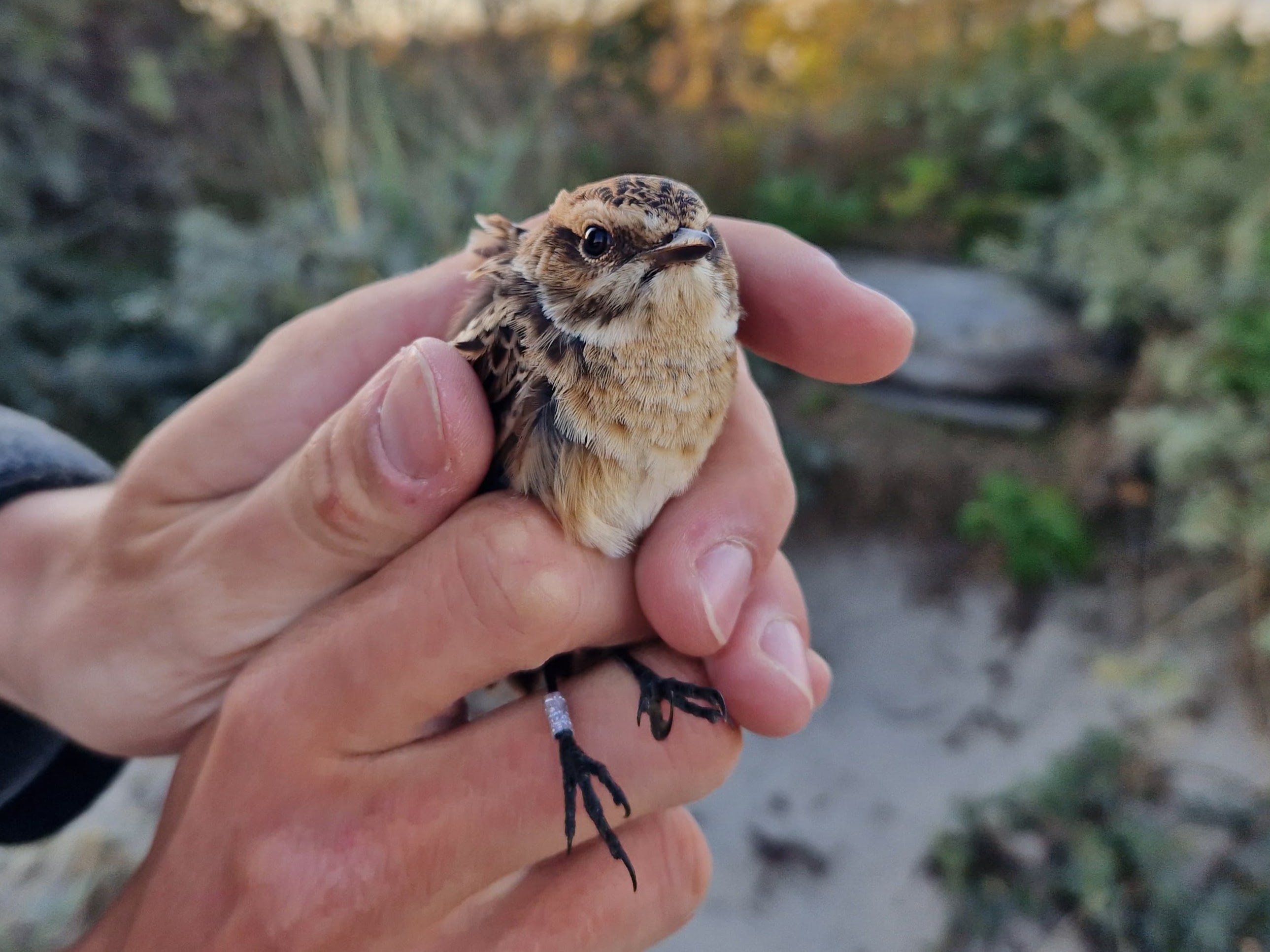
1K Whinchat (Bynkefugl)
Like a Whinchat (Bynekugl), a Pied Flycatcher (Broget Fluesnapper) and a Great Spotted Woodpecker (Stor Flagspætte) who knew exactly how to defend himself against the ringers.
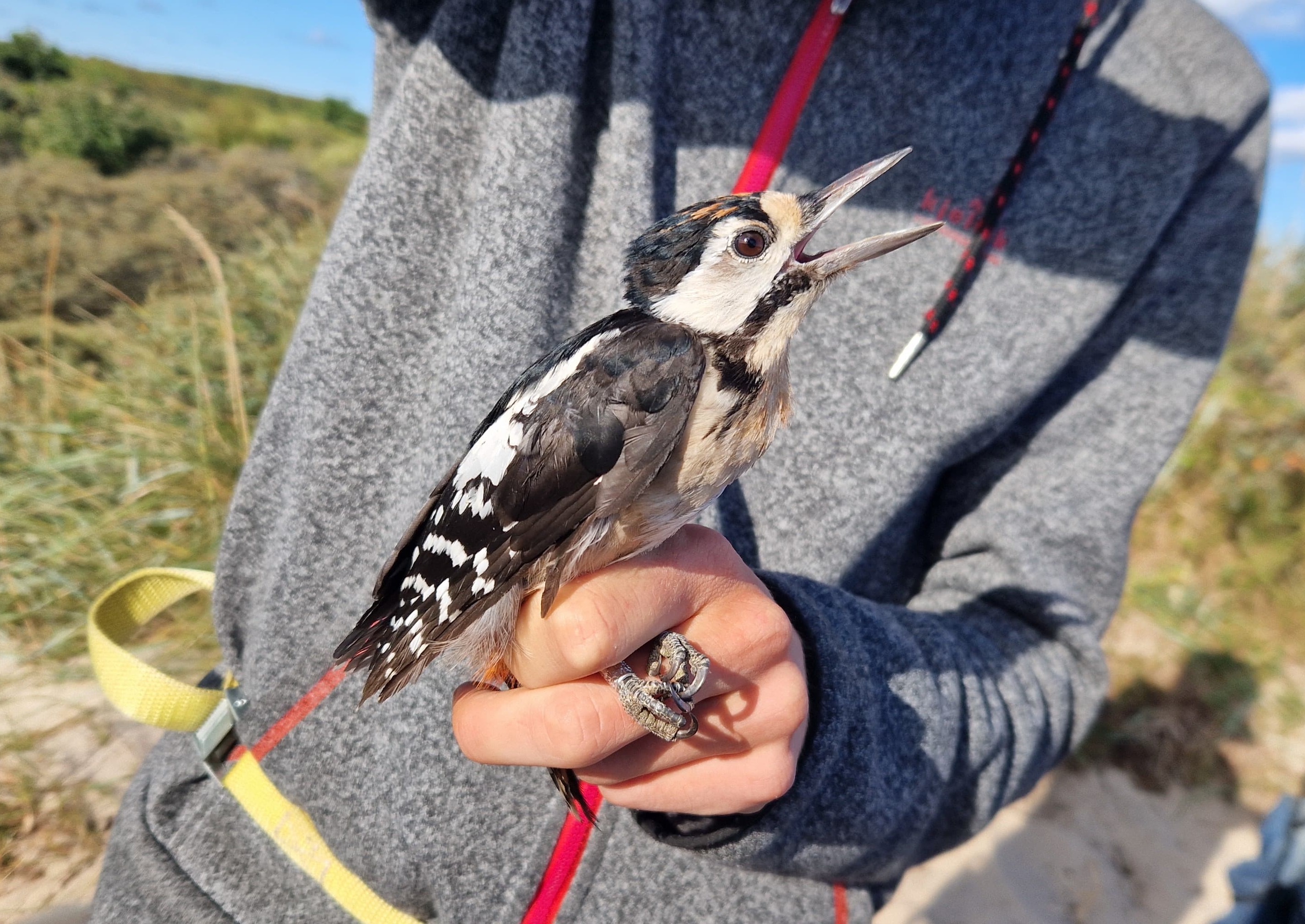
1K Great Spotted Woodpecker (Stor Flagspætte)
They had a good variety with 13 different species today and also caught the first bird in the new net they set up yesterday.
After coming back and doing the data we all had some very long naps and some of us also went for a swim.
Now we are preparing everything for going Wader catching together with Lars Bo at Jerup Strand tonight.
Ringing Kabeltrommlen:
Munk 1
Gærdesanger 2
Tornsanger 2
Rørsanger 1
Broget Fluesnapper 1
Dompap 2
Løvsanger 3
Jernspurv 1
Rødhals 1
Lille Gråsisken 1
Bynkefugl 1
Stor Flagspætte 1
Total: 21
Ringing Det Grå Fyr:
Natraven 1
Highlight of the observations:
Pomarie Skua - Mellemkjove!
arround 400 Gannets (Sule)
Today’s observations in Dofbasen from observers in the area
People: Rosemary Frikke, Markus Kemp Clément, Simon Kiesé, Louise Buksti-Ladefoged, Sarah Partrige, Cora Köberle, Simon S. Christiansen, Lars Bo Jacobsen.
